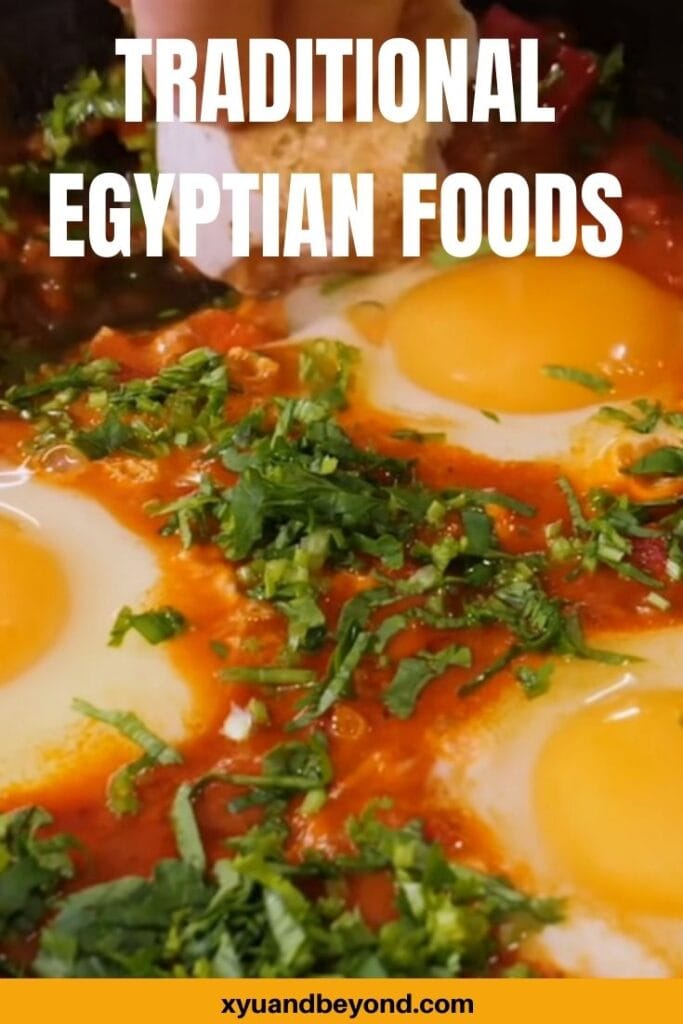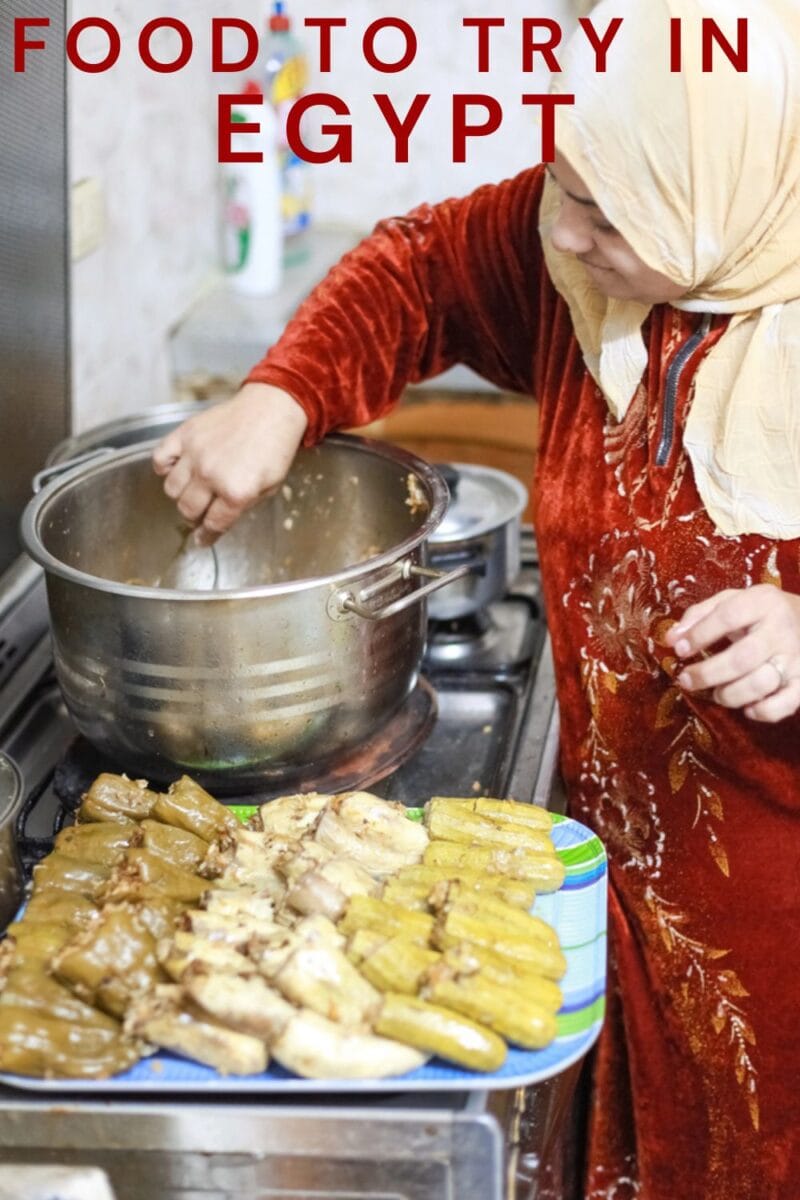Traditional Egyptian Food what you should eat in Egypt
When you think of Egypt the first thing that comes to mind is Ancient Egypt and the Great Pyramids of Giza. That alone makes Egypt a bucket list destination for many of us. The one thing that draws in a food tourist though is traditional Egyptian cuisine. With recipes and cooking techniques dating back thousands of years ancient Egyptian food is one of Africa’s most unique and fascinating cuisines.
On a vist to Egypt travellers want to experience Egyptian culture and Egypt’s culinary history has been influenced throughout history by Persia (Iraq), Greeks, Romans, Ottomans (Turkey) and Arabic cuisines going back thousands of years.
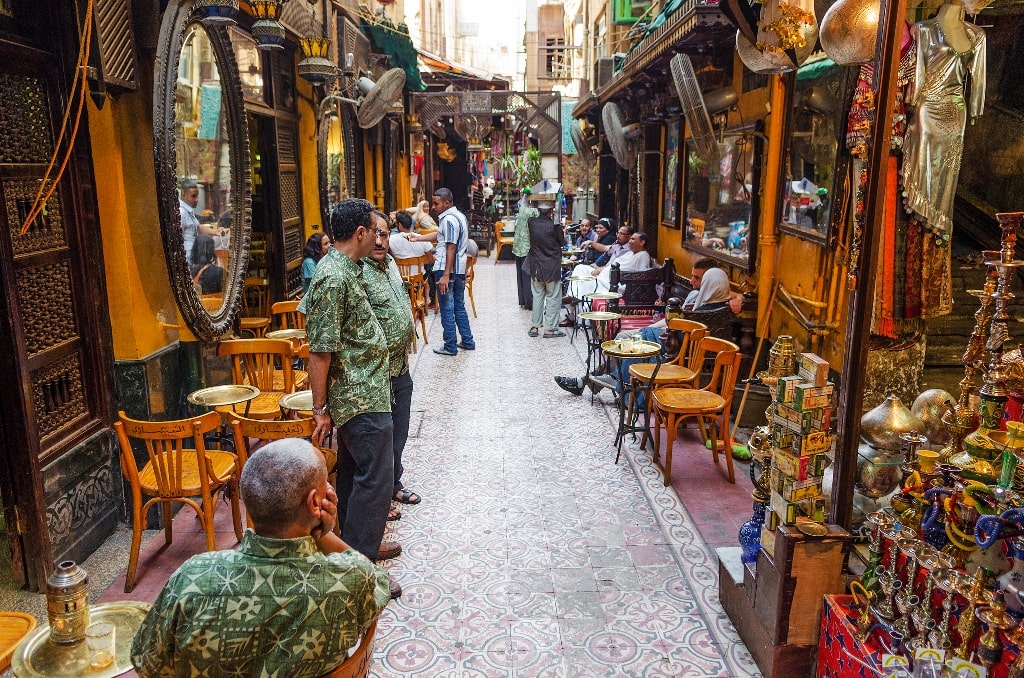
Ancient Egyptians were among the first to understand the science of baking. They invented the fermentation of dough and made pies and bread in all manner of shapes. Egyptian food culture was such that it was customary to eat three times and day and one of those meals had to include a family meal where everyone would sit down together.
When you do an Egypt tour you should know that the traditional food begins with bread. Bread was an essential part of the Egyptian diet and loaves of all types have been found in Egyptian tombs. The tomb of Ramses III held many types of pastries and bread found by archaeologists. In Thebe’s tomb, several lumps of brown lentils were found.
Lentils and beans were and still are the most common traditional Egyptian foods. Lentils and cowpeas were said to be the main diet of the pyramid builders. Foul or Ful beans were cooked in a variety of ways and also offered as tribute to the Egyptian gods these are some of the most tasty Egyptian dishes we enjoyed.
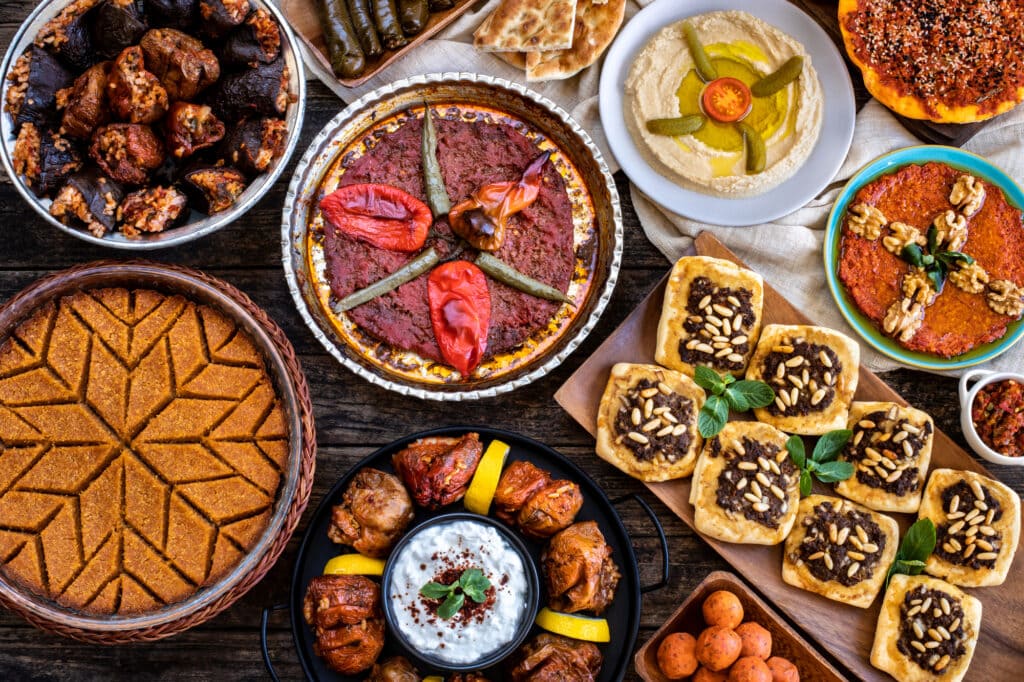
Vegetables were abundant thanks to the fertile Nile delta and included: lettuce, radish, green onions, watercress and cauliflower. Herbs grown along the delta were dill, parsley, cinnamon, cardamom, bay leaves, coriander (cilantro) and of course garlic.
A great deal of traditional Egyptian food was vegetarian although fish and seafood were prominent along the coastal regions. The most common meats were chicken, duck, beef and lamb along with squab a type of pigeon.
The spices used in Egyptian cooking include cumin, saffron, turmeric, coriander both the ground seed and the green herb, sesame, ginger, cardamom, mint used in tea and black cumin which is also known as Nigella seed.
Egypt’s history has made the food of Egypt what we see today. Each ancient civilization has left its imprint on what we call traditional Egyptian foods.
Frequently Asked Questions about Traditional Egyptian Food
What is traditional Egyptian food?
Traditional Egyptian food has a rich history and is a blend of various influences including Middle Eastern, Mediterranean, and African flavors. It often features unique spices, herbs, and ingredients native to the region.
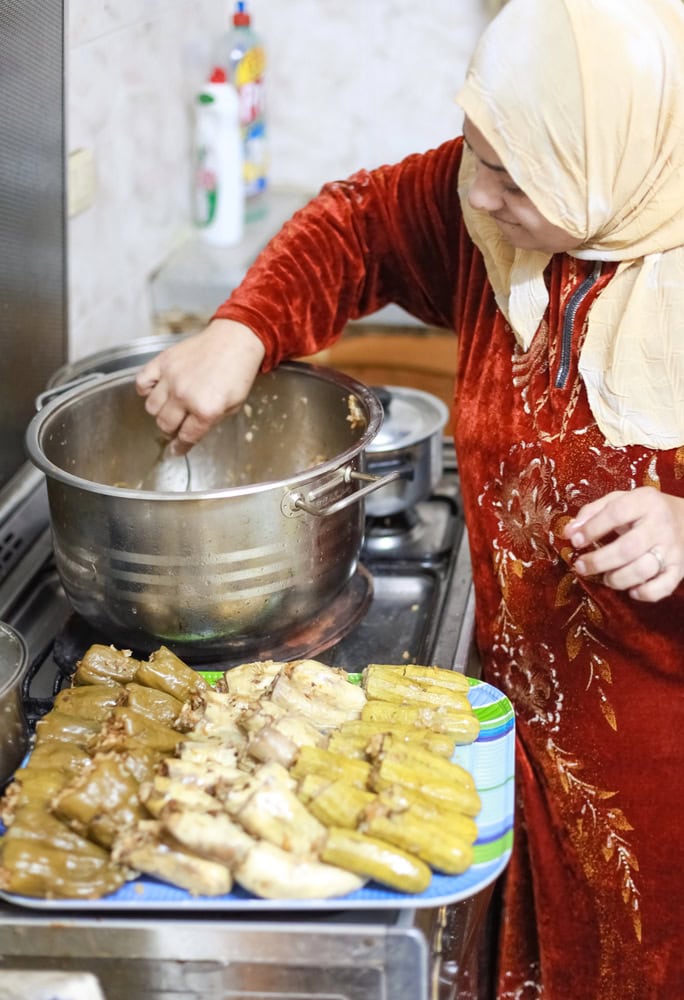
What are some popular traditional dishes in Egypt?
Some popular Egyptian dishes include koshari (a mixed dish of lentils, rice, macaroni, and tomato sauce), falafel (deep-fried balls made from ground chickpeas or fava beans), and molokhia (a hearty stew made from jute leaves).
Is Egyptian food suitable for vegetarians?
Yes, there are many vegetarian options in Egyptian cuisine such as vegetarian dishes like falafel, stuffed grape leaves, and assorted mezze platters with dips like hummus and baba ghanoush.
Where can I find traditional Egyptian food in Cairo?
You can find traditional Egyptian food at local restaurants, street food vendors, and markets throughout Cairo. Be sure to try popular dishes like koshari, ta’ameya (Egyptian falafel), and mahshi (stuffed vegetables).
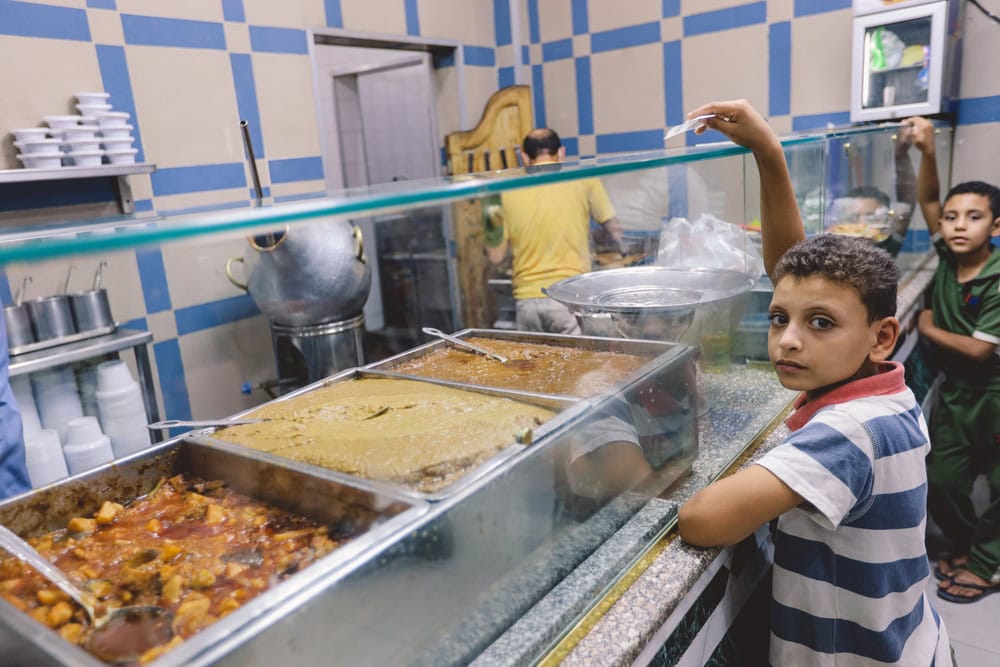
How does Egyptian food reflect the country’s culture?
Egypt’s food culture is deeply intertwined with its history, traditions, and celebrations. Many dishes have been passed down through generations, symbolizing hospitality, family gatherings, and festive occasions.
Can you recommend some ‘must-try’ traditional Egyptian dishes?
When traveling to Egypt, be sure to try dishes like Egyptian rice with vermicelli, shawarma (grilled meat in pita bread), and konafa (a sweet pastry dessert). These are some of the most beloved and delicious dishes in Egyptian cuisine.
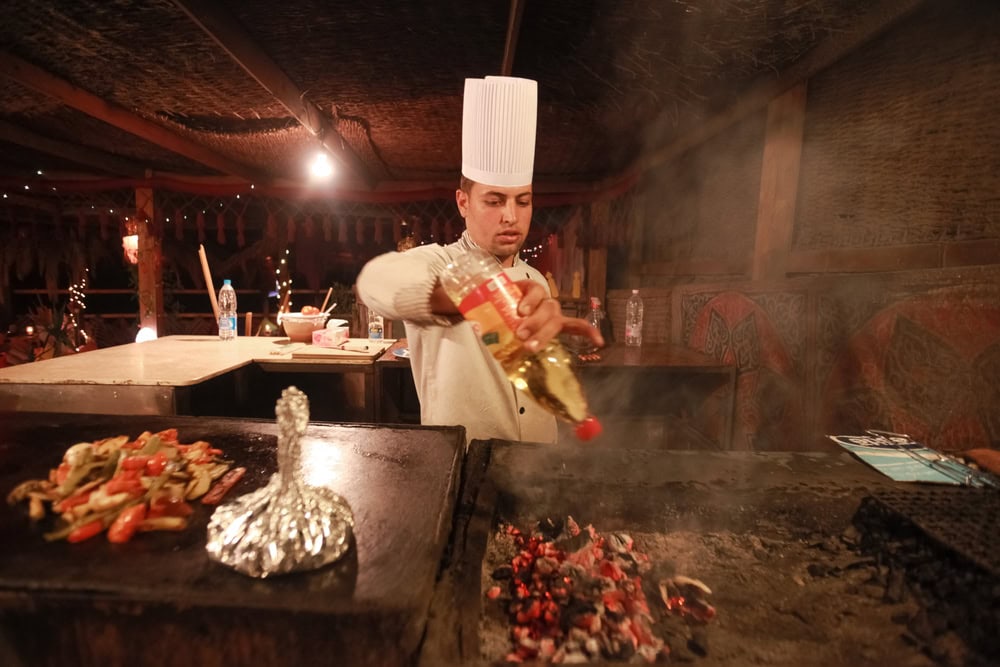
What are some famous Egyptian street foods?
Some famous Egyptian street foods include ta’ame or Ta’ameya (Egyptian Falafel). Made from fava beans and deep-fried, these patties are often served in pita bread with tahini sauce and salad.
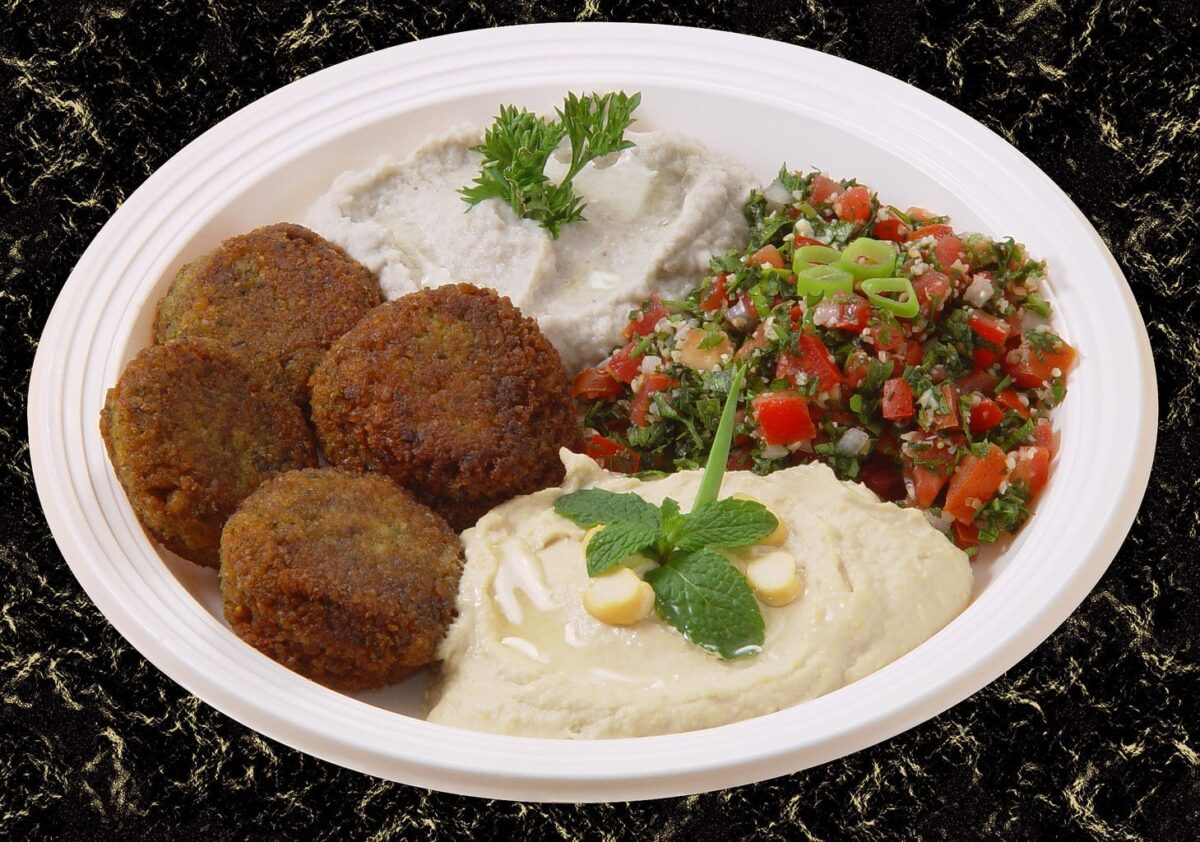
Shawarma: Marinated and roasted meat (beef, chicken, or lamb) served in pita bread with garlic sauce, tahini, and various salads.
Hawawshi: Pita bread stuffed with spiced ground beef and baked until crispy and juicy.
Sambousak: Deep-fried pastry pockets filled with spiced meat, cheese, or vegetables, similar to samosas.
What is the most popular Egyptian food?
The two most popular Egyptian dishes are ful medames and koshari.
- Traditional Egyptian Food what you should eat in Egypt
- Frequently Asked Questions about Traditional Egyptian Food
- What is traditional Egyptian food?
- What are some popular traditional dishes in Egypt?
- Is Egyptian food suitable for vegetarians?
- Where can I find traditional Egyptian food in Cairo?
- How does Egyptian food reflect the country's culture?
- Can you recommend some 'must-try' traditional Egyptian dishes?
- What are some famous Egyptian street foods?
- What is the most popular Egyptian food?
- Traditional Egyptian Food
- Ful Medames
- Tamiya
- Koshari: Egypt's national dish
- Hamam Mahshi/Pigeon/Squab
- Fatta
- Molokhia/mulukhiyah/molokheyya
- Feseekh
- Macaroni Béchamel
- Fiteer Baladi
- Mombar/Fawaregh
- Mahsi
- Baba Ganoush
- Hummus
- Shawarma
- Kebab and Kofta
- Bissara/Besarah
- Shakshuka
- Eggah/Ej’jah
- Bamya
- Egyptian Fattah
- Kebdah/Kebda Eskandarani
- Feteer Meshaltet
- Hawawshi
- Egyptian Cheese
- Traditional Egyptian bread
- Traditional Egyptian Desserts
- Egyptian Drinks
- Frequently Asked Questions about Traditional Egyptian Food
Traditional Egyptian Food
Here are some top traditional Egyptian food favourites that every visitor should try at least once when coming to this beautiful country, from breakfast to dessert.
Ful Medames
Ful is one of the most common traditional Egyptian foods and the most famous Egyptian food and is sold as street food all over Egypt. It is one of the most popular snacks in Egypt and a staple of most Egyptian’s diets. Ful‘s main ingredient is Fava beans that have been cooked in oil with salt, cumin, lemon juice and garlic. The beans are mashed and served on pita bread.
In Egyptian homes, Ful is commonly eaten as a dish with eggs, cheese, pita bread and/or also popular food like tameya which is a falafel dish.
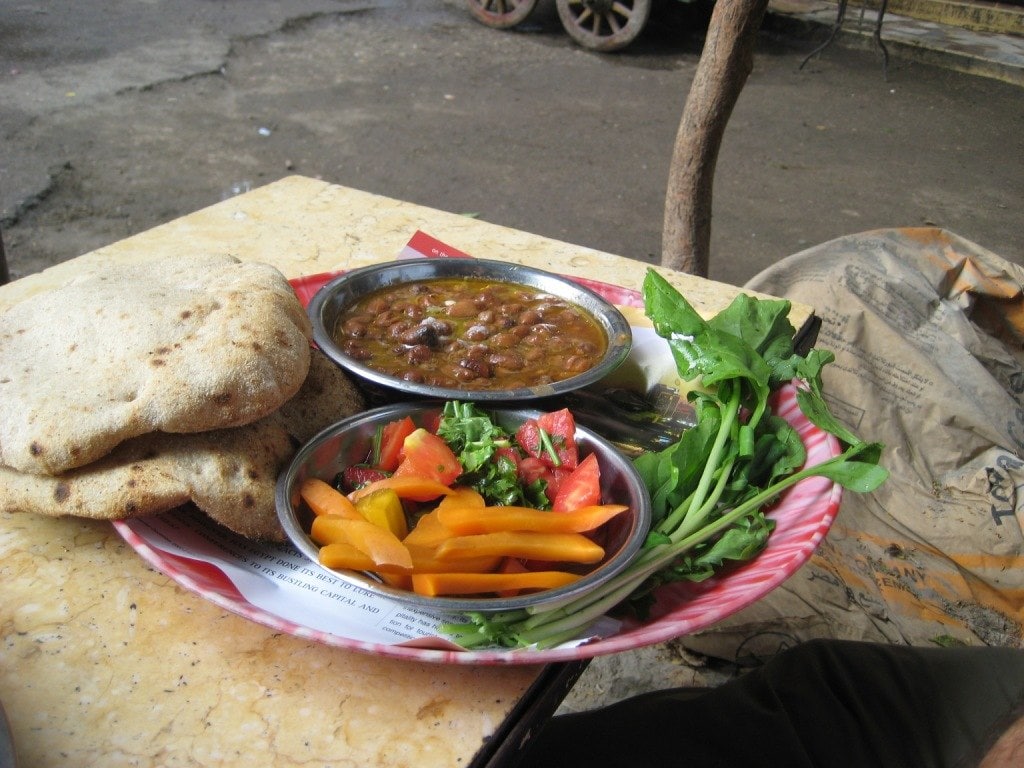
Tamiya
The most popular food in Egypt is Tamiya which is considered the National Food of Egypt and although similar to Falafel it is made with mashed fava beans instead of chickpeas.
The beans are ground and seasoned with a mix of fresh cilantro, parsley, white onion, garlic and leek, along with spices including cumin, cayenne, paprika, salt and pepper and coriander.
Like koshari and ful medames, it’s one of the most well-known traditional Egyptian dishes, so much so that you can even order a McFalafel at McDonald’s across Egypt.
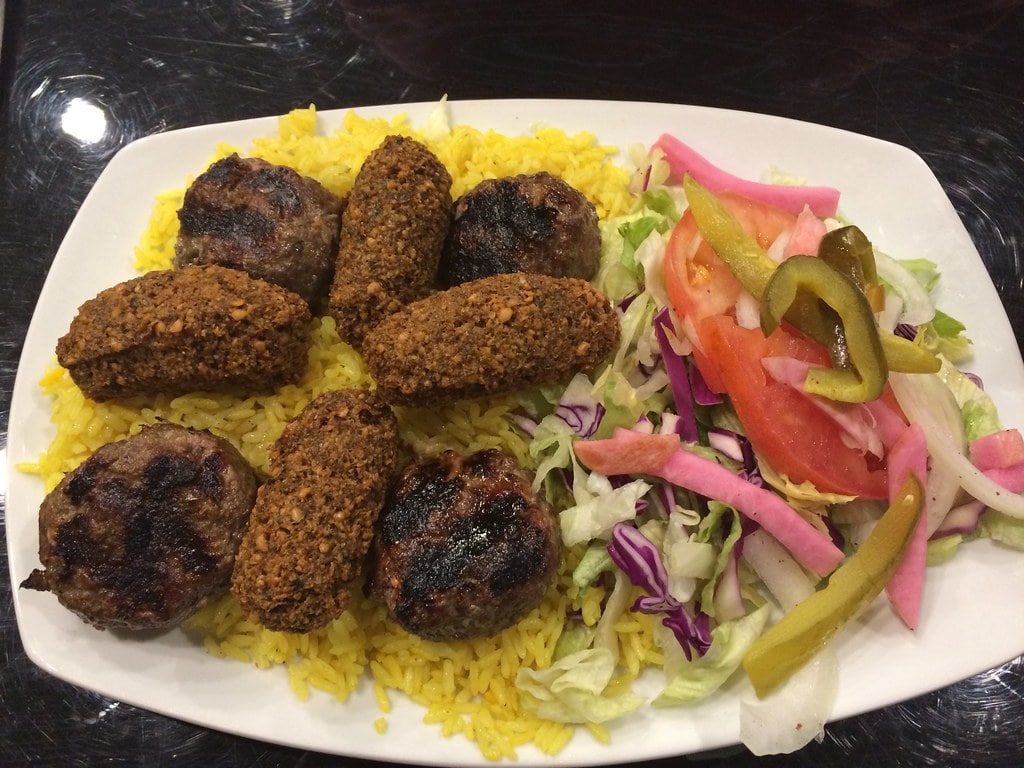
Koshari: Egypt’s national dish
One of the famous Egyptian dishes, and Egypt’s most popular food is the one I most enjoyed on a tour of the pyramids. Koshari is a mix of rice, brown lentils and macaroni topped with fried onions and a spicy tomato sauce. Koshari is also considered a national dish of Egypt.
Koshari dates back to mid-19th century Egypt and was basically invented by Egyptian housewives and servants who created it out of leftovers. It was sold from street carts to workers but later was introduced into restaurants and is now a much-loved comfort food.
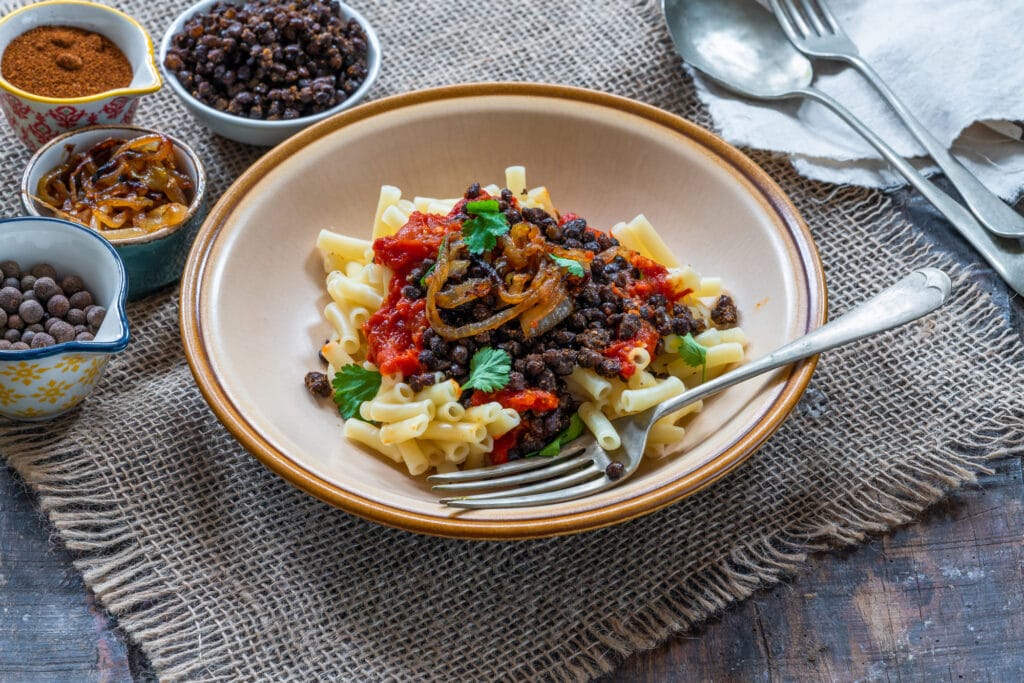
Hamam Mahshi/Pigeon/Squab
Hamam mahshi is a stuffed pigeon and has been served in Egypt for centuries. The pigeons are kept in mud-brick lofts that can be seen along the Nile. The bird used is called a squab as it is a young domesticated pigeon much like a chicken is domesticated.
The Hamam is stuffed with freekah which is cracked wheat and rice and then seasoned with giblets, nuts and spices. This traditional Egyptian dish is usually kept for special occasions and festive holidays.
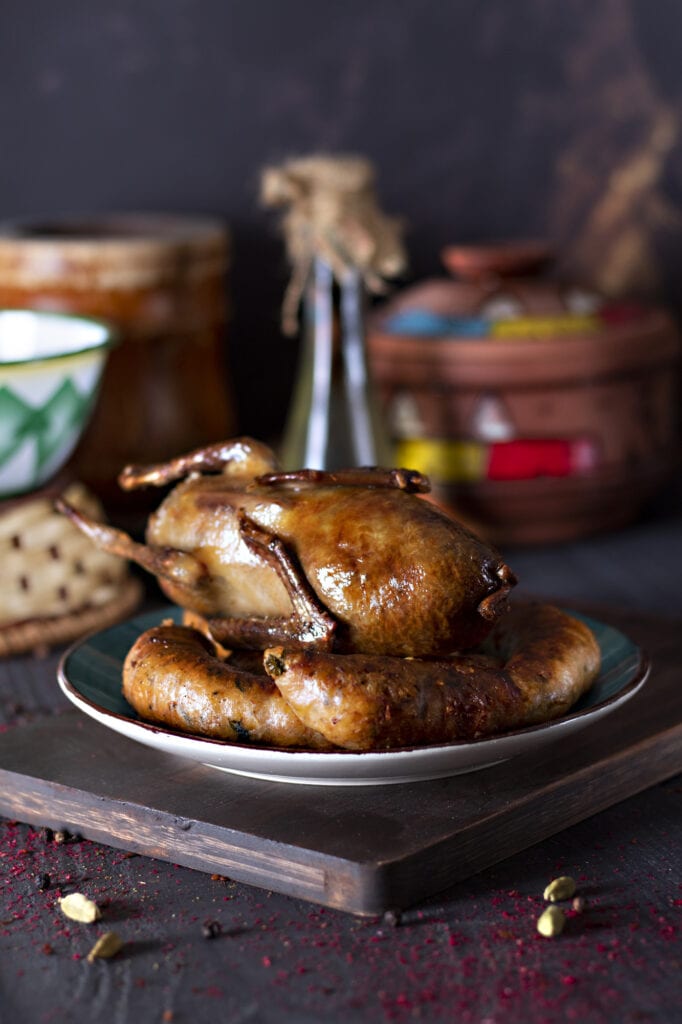
Fatta
An Egyptian Christmas food Fatta is a dish consisting of bread, rice, garlic, boiled lamb cubes and garlic sauce. Some like to have it with tomato paste on top, but the majority prefer the accentuated garlic flavour of traditional Egyptian fatta. On Coptic Christmas Day (January 7th), friends and family gather in homes for the festivities, and people enjoy Fatta together.
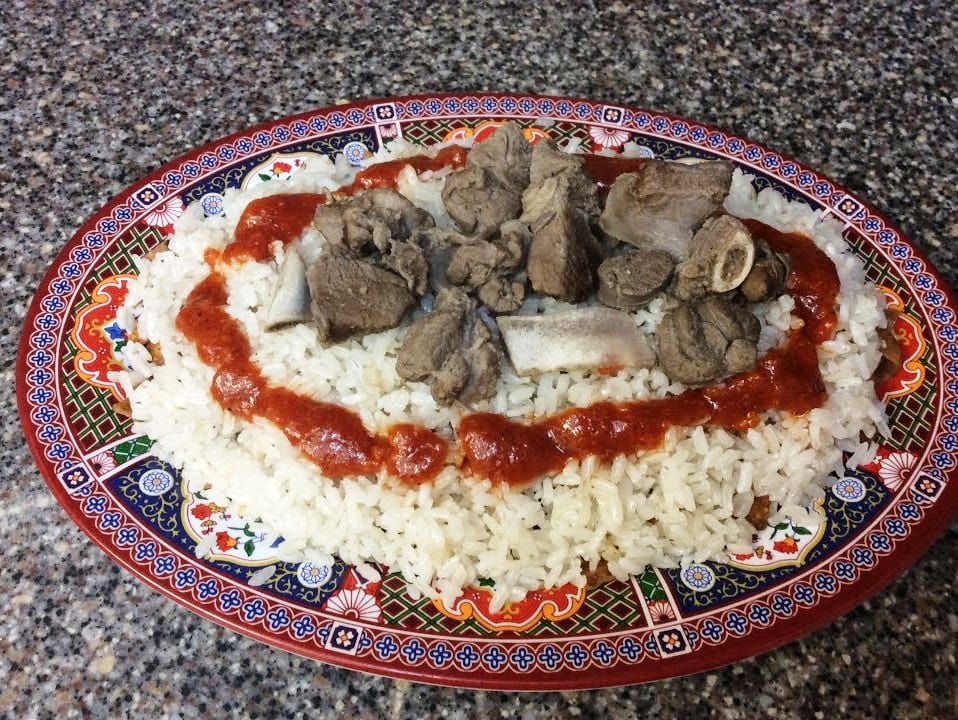
Molokhia/mulukhiyah/molokheyya
This dish dates back to Ancient Egypt and I have to to admit not my favourite of the traditional Egyptian dishes. Molokhia is made from the leaf of a Mallow plant. The leaves are finely chopped and boiled in chicken broth with garlic, coriander and seasonings. The soup tends to be almost jelly-like and reminded me of another dislike – okra.
Molokhia soup is usually served with rice or flatbread and is often paired with meat dishes like roasted chicken, rabbit, or seafood.
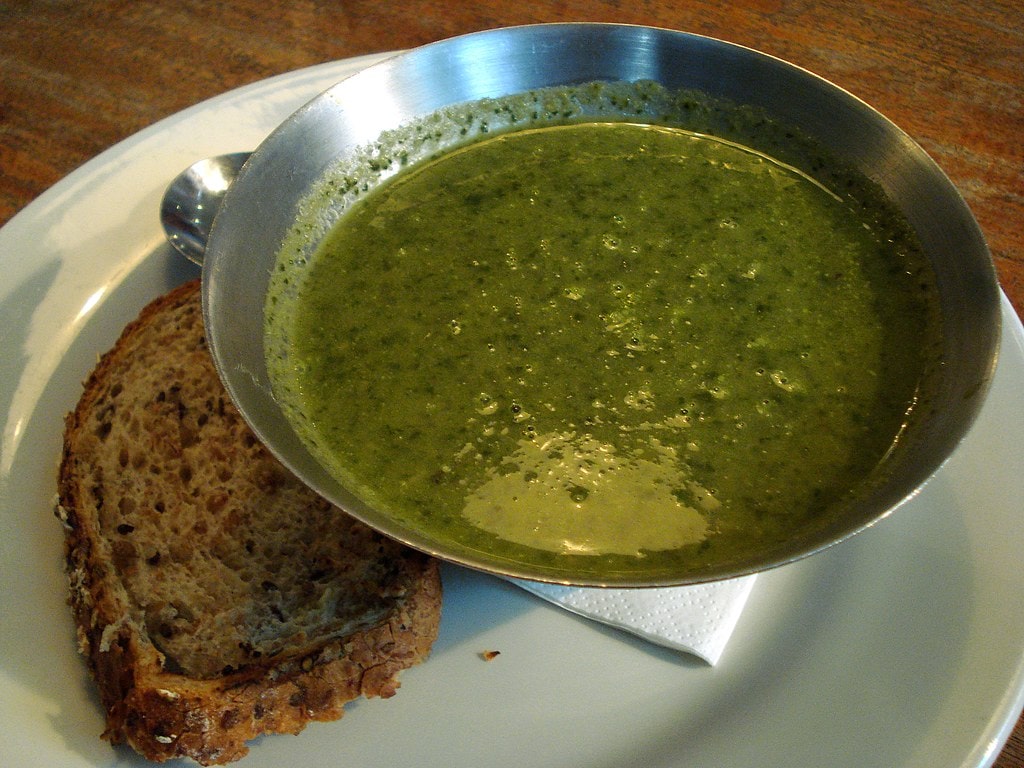
Feseekh
Feseekh is a traditional Egyptian dish made from fermented, salted, and dried grey mullet fish. It is particularly associated with the spring festival of Sham El Nessim, which dates back to ancient Egyptian times and is celebrated on the Monday following Coptic Easter.
Macaroni Béchamel
This is an Egyptian pasta dish that was introduced to Egypt by Greek and Italian immigrants Macaroni Béchamel is exactly what you think it is. Made with ground beef cooked in a lightly spiced tomato sauce with onions and various spices including cumin, nutmeg, cinnamon, coriander and garlic it includes cooked rigatoni noodles layered with the sauce and then Bechamel sauce and cheese.
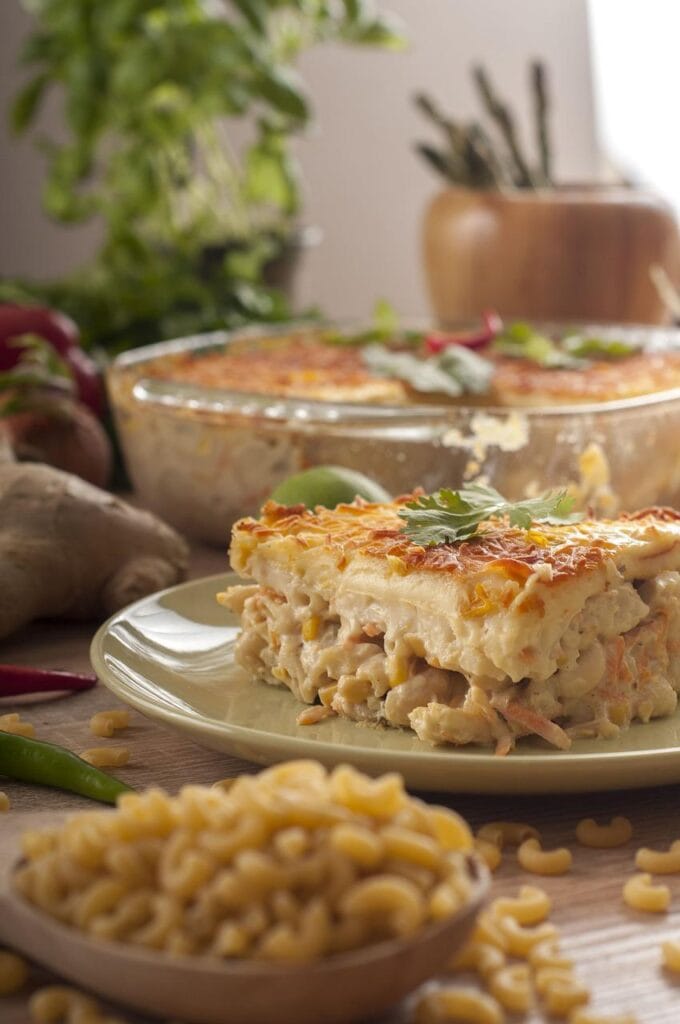
Fiteer Baladi
Called the Egyptian pizza the ‘crust’ is made from layers of filo pastry the original is simply the filo layered with butter or you can order it sweet with honey or savoury with ground meat, cheese and vegetables.
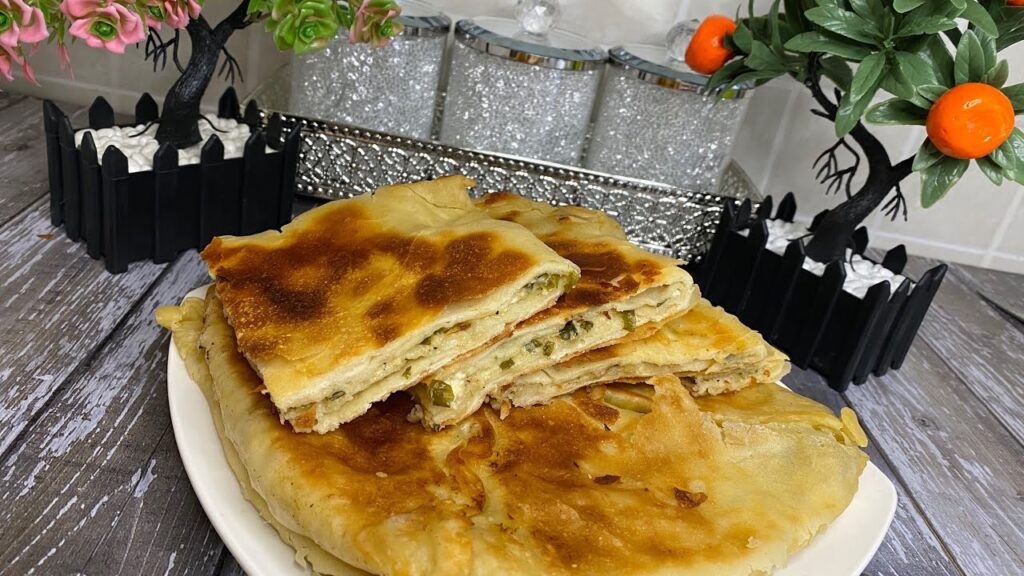
Mombar/Fawaregh
Mombar is a traditional Egyptian sausage. The sausage stuffing is usually ground beef mixed with rice, onions, garlic, and tomato paste and the seasonings include cinnamon, coriander, cumin, parsley and cilantro. The sausages are usually boiled first and then fried to a deep golden brown.
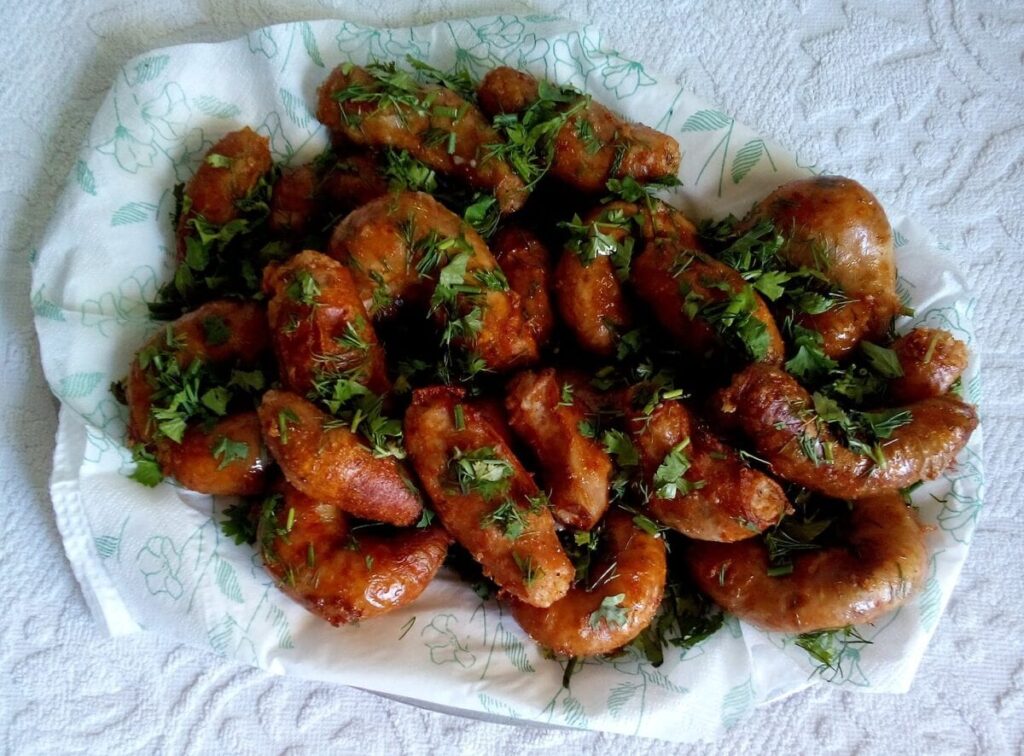
Mahsi
Mahshi is at heart a vegetarian dish and involves any vegetable of choice stuffed with a rice filling, such as zucchini, eggplants, bell peppers, tomatoes, cabbage leaves, or grapevine leaves making it similar to Greek dolma.
The filling consists of rice, herbs (parsley, cilantro, and dill), tomato sauce with seasoning and a touch of cinnamon. Some people like to add minced meat to the filling for a generous meal.
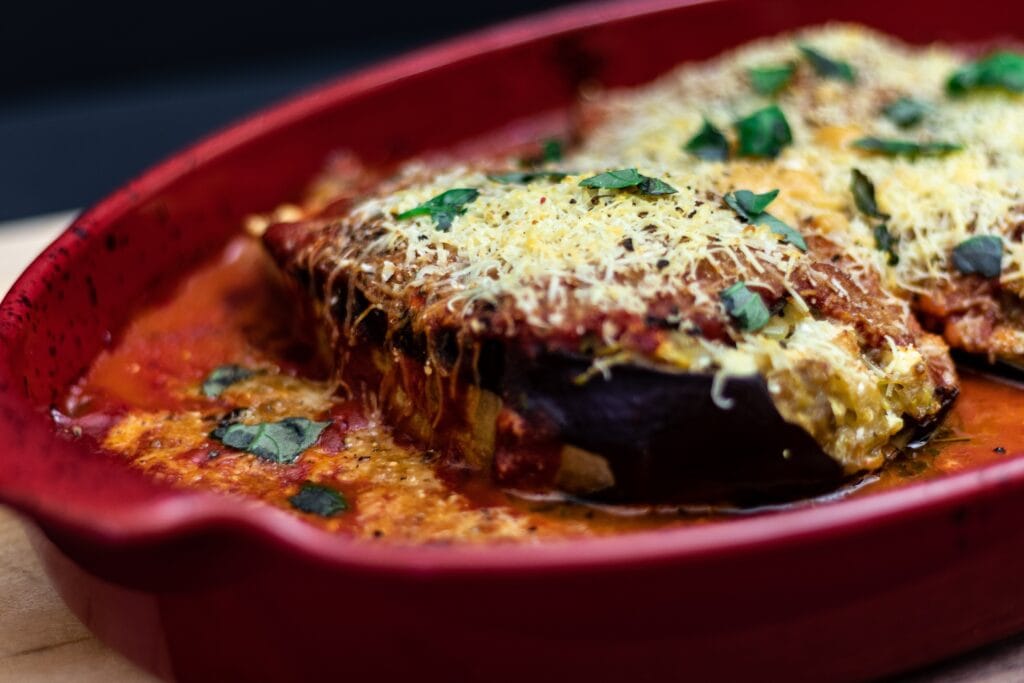
Baba Ganoush
One of the most popular dips served in Egyptian cuisine is Baba Ghanoush which most folks like to think comes from Lebanon. Here in Egypt, you will find it on every menu as it really is an ancient dish from the Levant.
Baba Ganoush is made from roasted cooked and mashed eggplant that like hummus has been blended with Tahini, olive oil, garlic, lemon juice and sometimes herbs and spices.
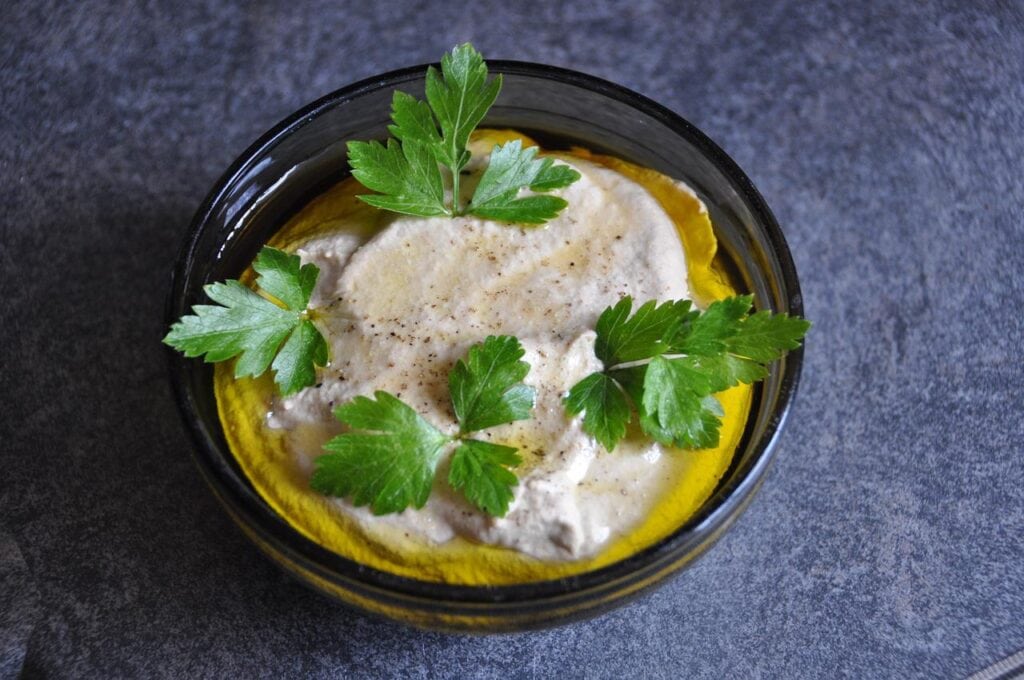
Hummus
Hummus is that dish we all serve at parties for an appetizer – perfect with a variety of cut veggies to dip. Did you know that in Arabic hummus means chickpeas?
The exact origins of the dish are unclear, but the earliest written Egyptian recipes for a dish resembling hummus are recorded in cookbooks written in 13th-century Cairo.
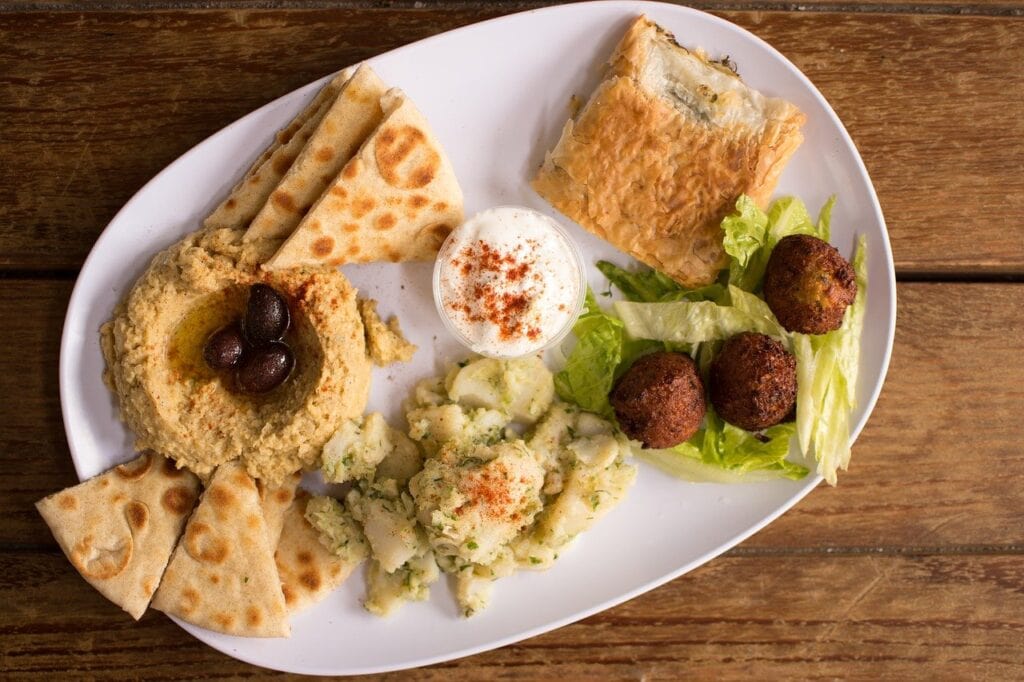
Shawarma
Shawarma is a type of kebab, you will recognize the large cone of lamb or chicken on a rotisserie in many of the local kebab houses in Egypt.
As the meat cooks over the flames it is sliced in very thin pieces and then mixed with chopped onion, parsley and tomatoes which are rolled up in pita bread. The shaved meat is served with tahini and a chicken shwarma is served with tomato and garlic sauce. The perfect Egyptian street food.
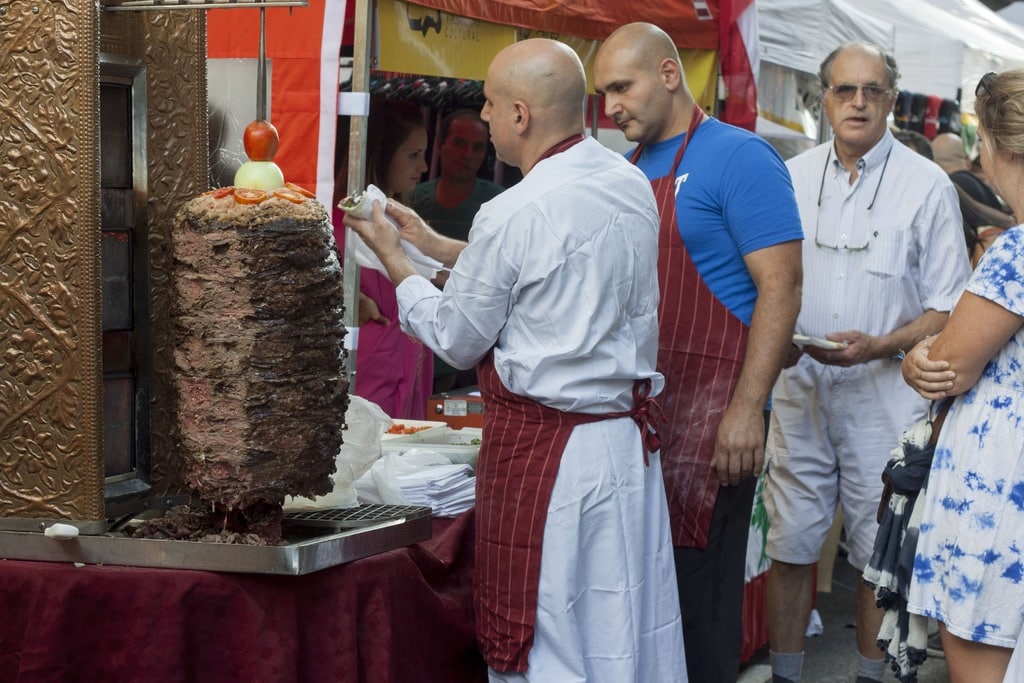
Kebab and Kofta
These are comprised of grilled chunks of lamb (kebab) and spiced ground meat made into a sausage shape formed over a metal skewer (kofta). They are seasoned with onions, garlic, and a host of herbs and spices like parsley, mint, sumac, nutmeg, cardamom, allspice, cumin, and paprika
These are typically eaten with a simple chopped tomato and cucumber salad and a flatbread.
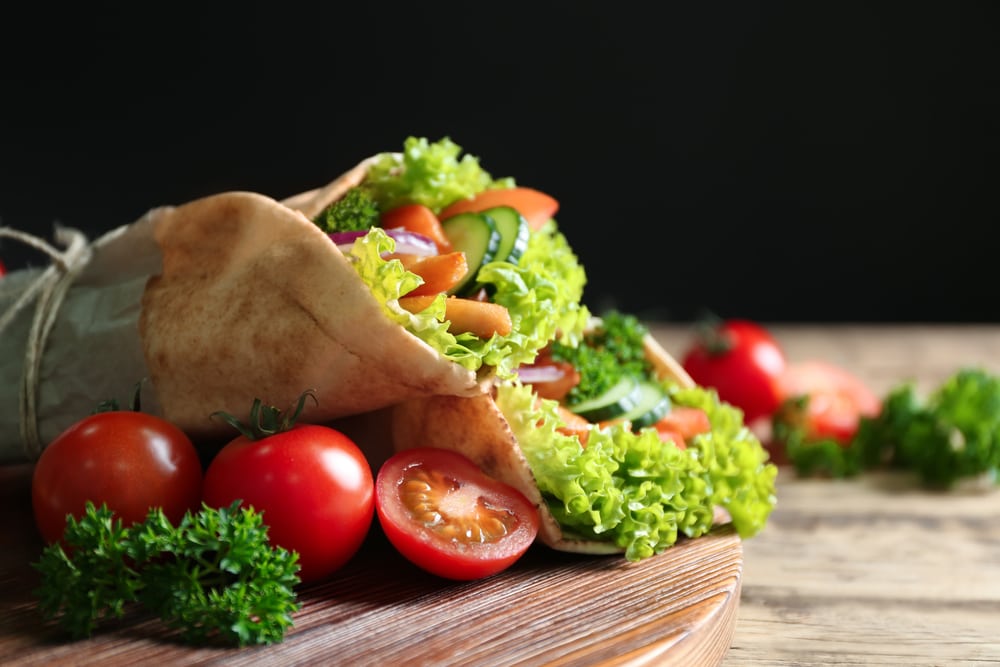
Bissara/Besarah
This is a creamy green puree very much like hummus and eaten in Egypt with bread to dip into the mixture. The mixture is usually pureed broad beans mixed with garlic, lemon juice, olive oil, hot chilis, cumin and salt.
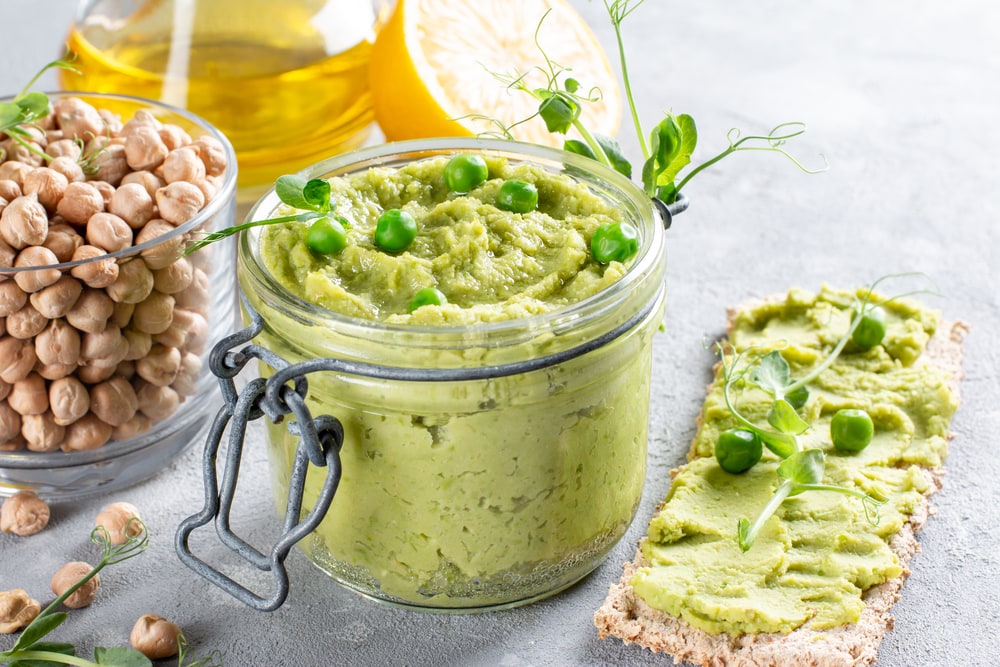
Shakshuka
The traditional Egyptian breakfast food Shakshuka is one of the most well-known Levantine dishes it is descended from the Maghrebi cuisine and is very popular in Egypt.
Shakshuka is made with eggs poached in a tomato sauce made with tomatoes, garlic, green pepper, bell peppers, onions, and olive oil. The word shakshuka in Arabic means “shaken together” or “mixed”.
Shakshuka is the most popular Egyptian breakfast and Egyptians love to combine it with a mezze platter where it can sometimes be made with ground beef or lamb and naturally eaten with warm pita bread.
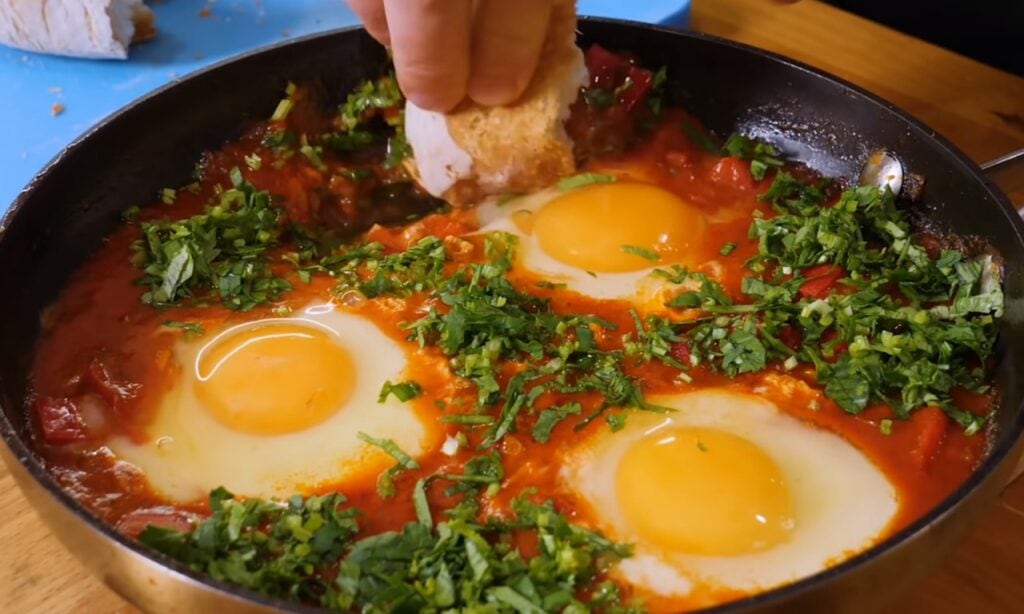
Eggah/Ej’jah
This is like a Spanish frittata a thick egg omelette that is baked with a variety of ingredients like tomatoes, eggplant, peppers and onions. It is seasoned with cumin, garlic, cinnamon, turmeric, nutmeg and fresh herbs. A very traditional Egyptian dish it is served all day.
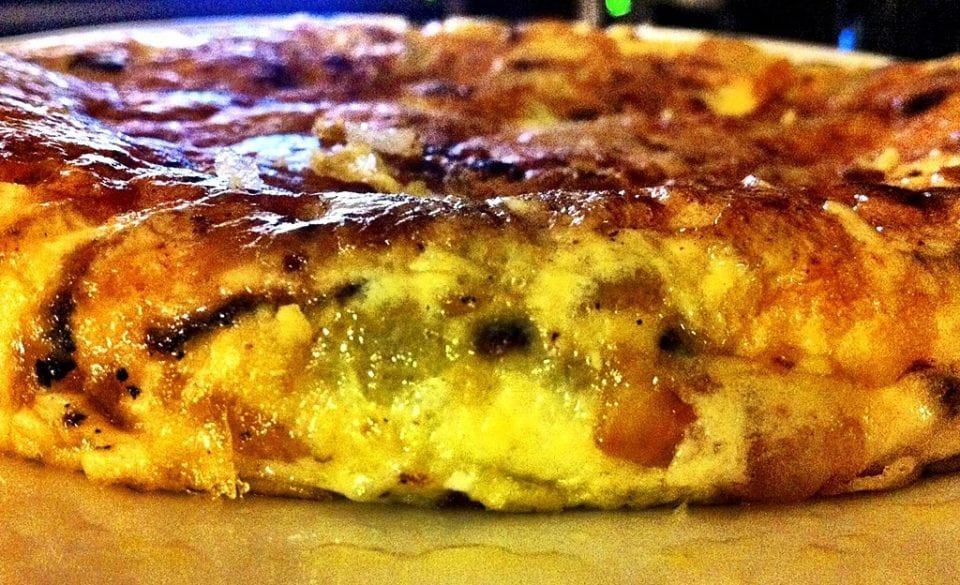
Bamya
Bamya is an Egyptian stew made with lamb, okra and a sauce of tomatoes, onions, peppers, cilantro, garlic and spices. In Arabic bamya means okra. It can be made of beef or lamb and is served with pita bread and white rice.
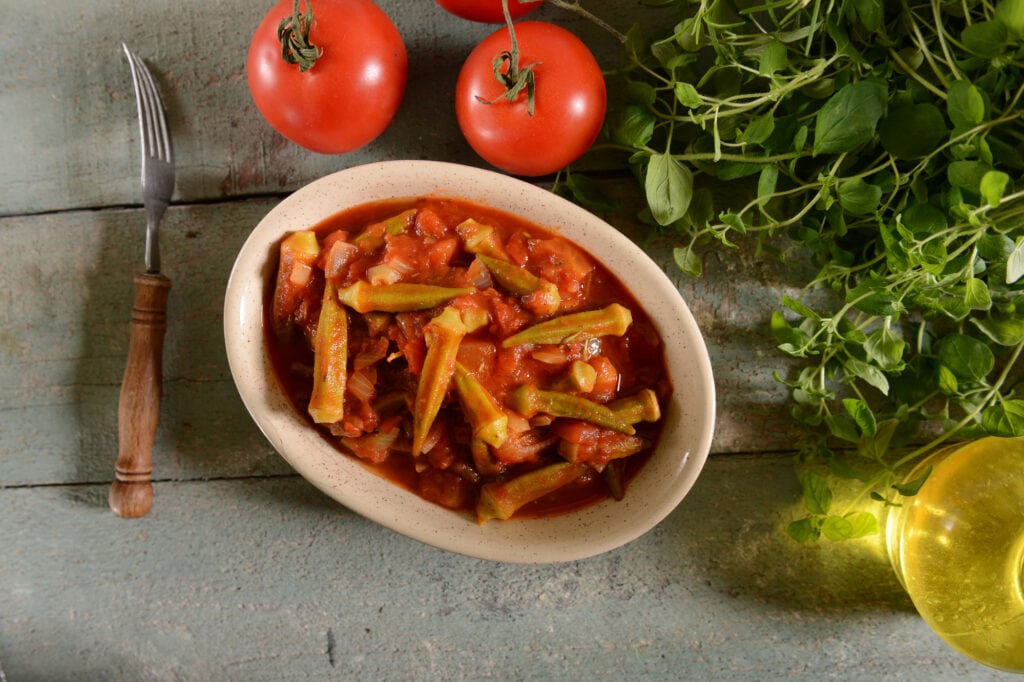
Egyptian Fattah
This is a dish of spiced meat (beef or chicken), rice, garlic, and layers of dry bread soaked in broth, then served with a warm garlic and tomato sauce. This is a traditional Egyptian food to celebrate any occasion, Fattah is served at weddings, gatherings, during Ramadan and celebrating a new baby
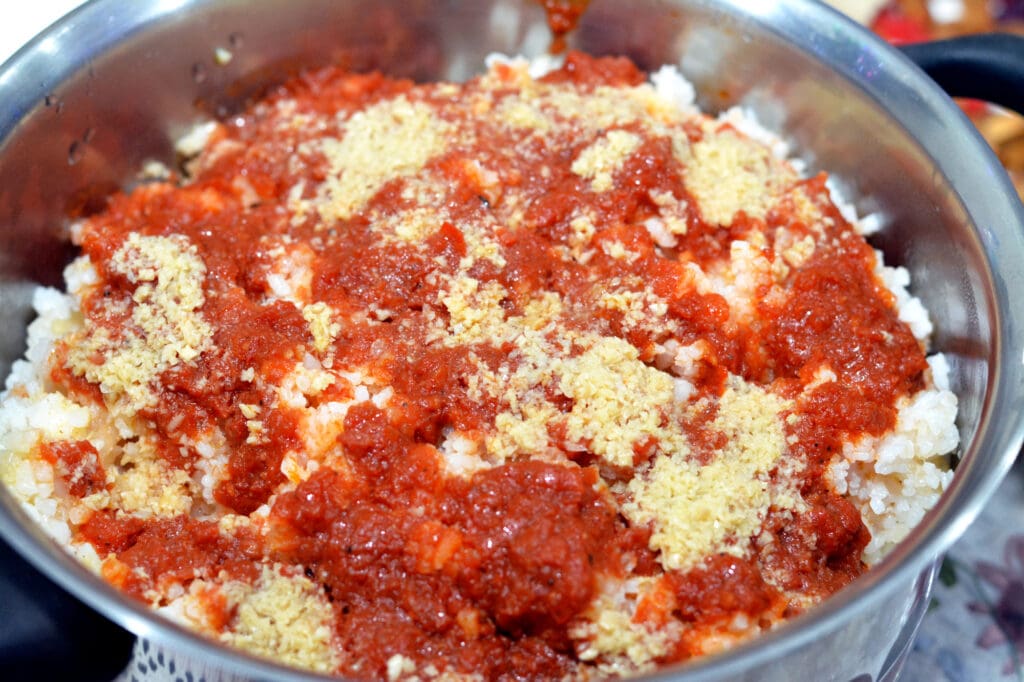
Kebdah/Kebda Eskandarani
Kebdah is a popular street food in Egypt. This is a kind of sausage first created in Alexandria. The sausage meat is from ground beef liver flavoured with hot peppers, garlic and onion and then served with pickles on a bun similar to an American hot dog bun. An incredibly popular Egyptian street food dish this can now be found all over Egypt.
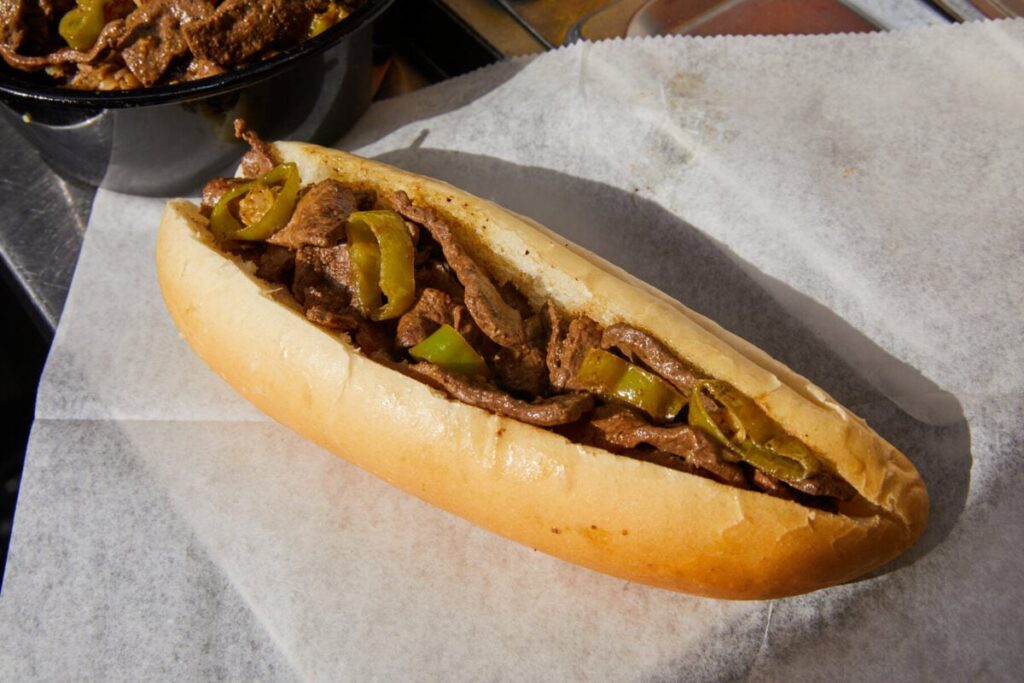
Feteer Meshaltet
Feteer meshaltet translates literally as “cushioned pies” and it is a flaky, buttery pastry with fillings that range from sweet to savoury.
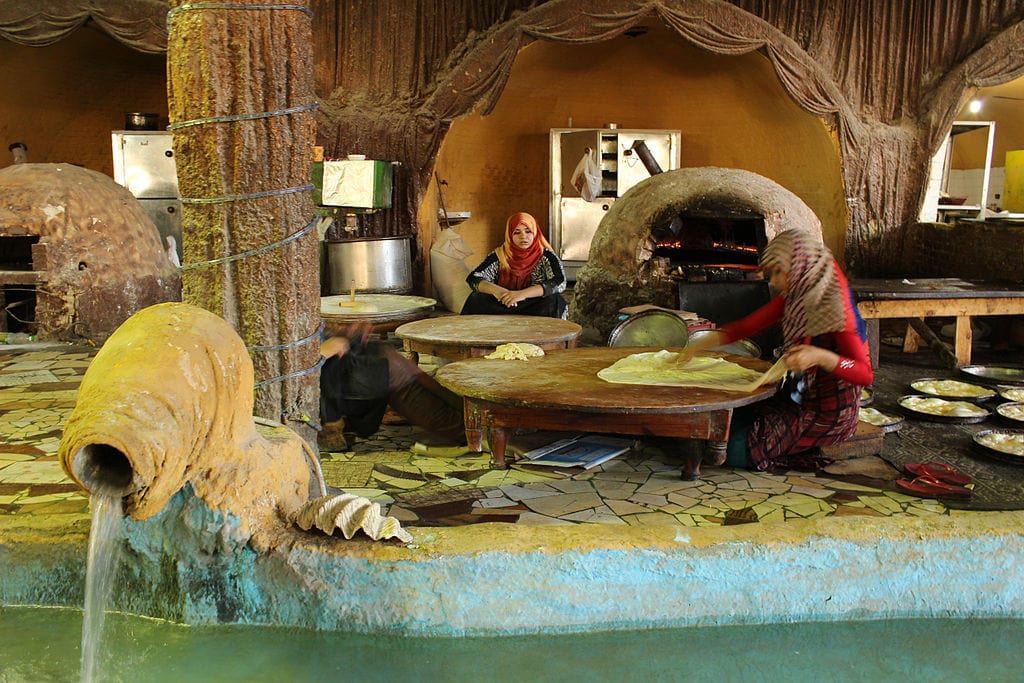
Hawawshi
Hawawshi is popular Egyptian street food and it is basically an aish Baladi dough stuffed with a mixture of ground beef that is seasoned with spices, onions, garlic, hot peppers and fresh herbs.
Egyptian Cheese
Not something you think of when you think of Egypt but cheese is definitely a staple here. Over 5000 years ago folks were making cheese in Egypt. Remnants of cheese were found in ancient alabaster jars at Saqqara and other Egyptian digs.
Domiati, Ras, Kareish and Mish are some traditional types of cheeses produced in Egypt.
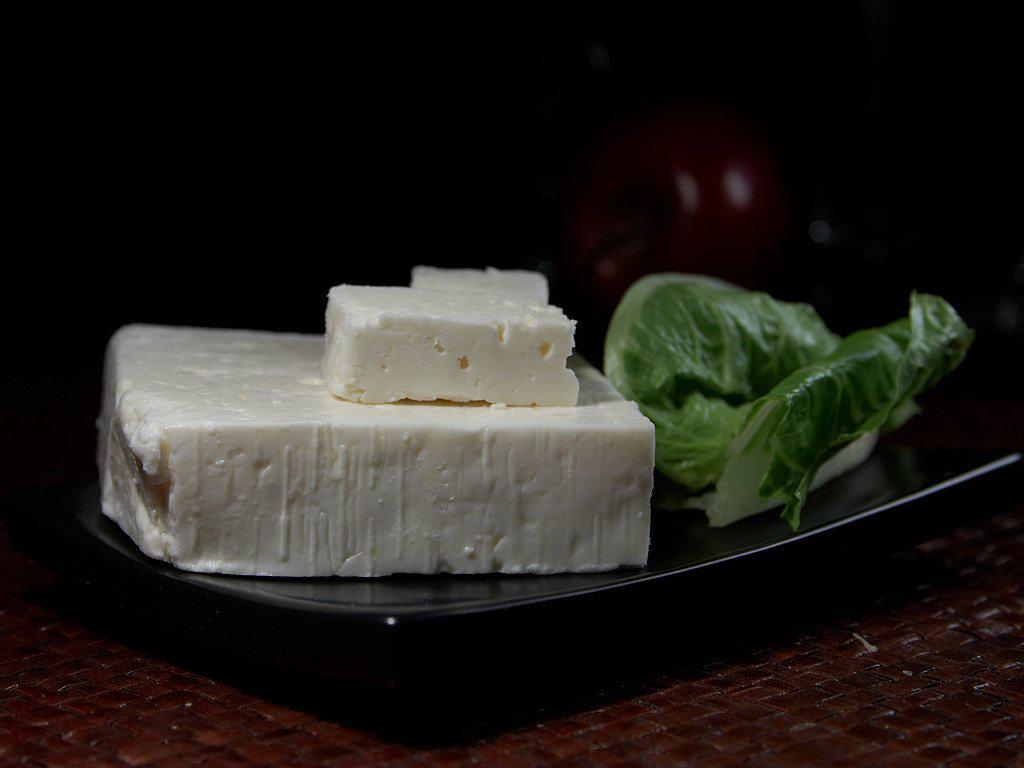
Mish Cheese
Mish is made from buffalo milk and cream. Mish is fermented in whey for a long time, in fact, it is also called old cheese or jibneh qadima and the best way to eat it is with tomatoes and onion.
Domiati/Gibna Bayda
Domiati cheese is the most popular soft white feta-like cheese made from buffalo milk, cow, sheep, goat or camel milk depending on the region where you have it.
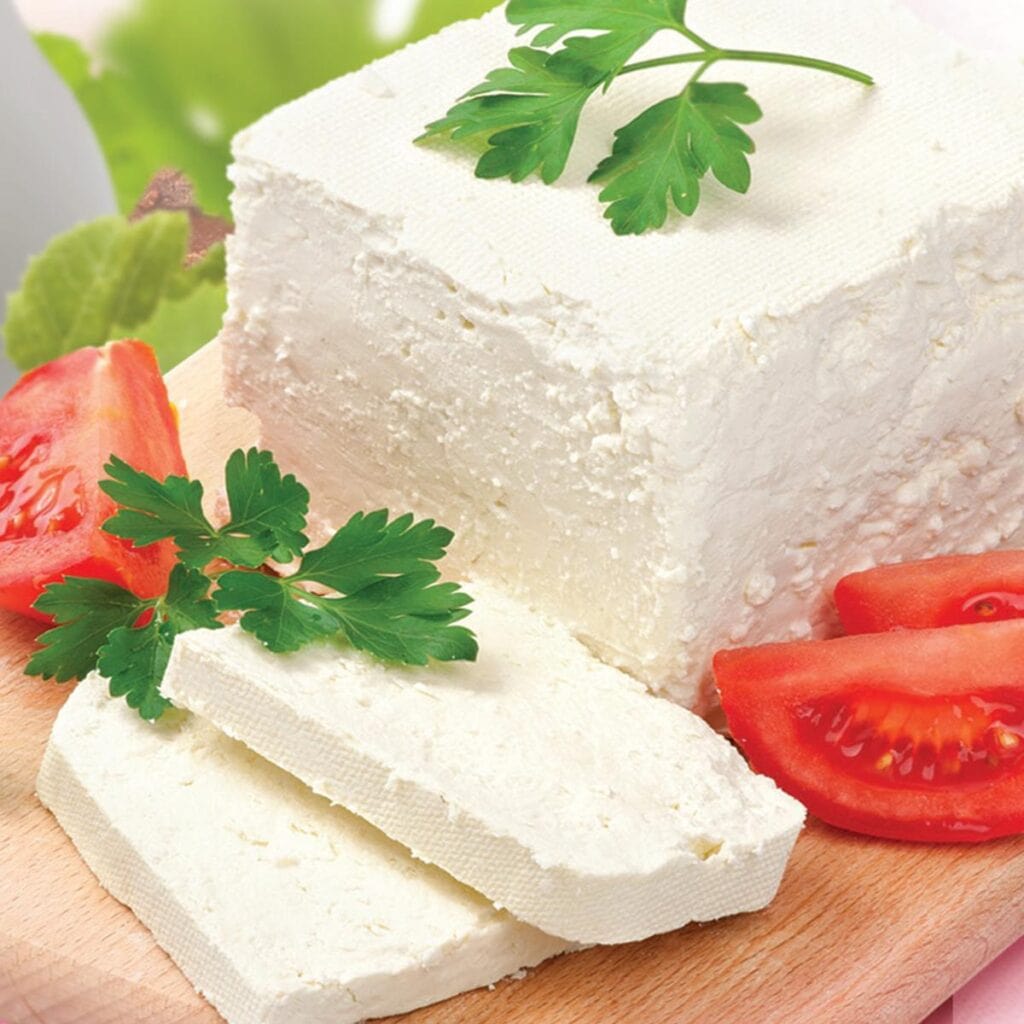
Ras Cheese
Ras cheese is the most popular hard cheese. Buffalo and cow’s milk or a mixture of both is used to prepare these two types of cheeses.
Areesh
Similar to cottage cheese but it is made from yoghurt which is slowly heated until it separates and curdles, and it is then placed in cheesecloth in order to drain.
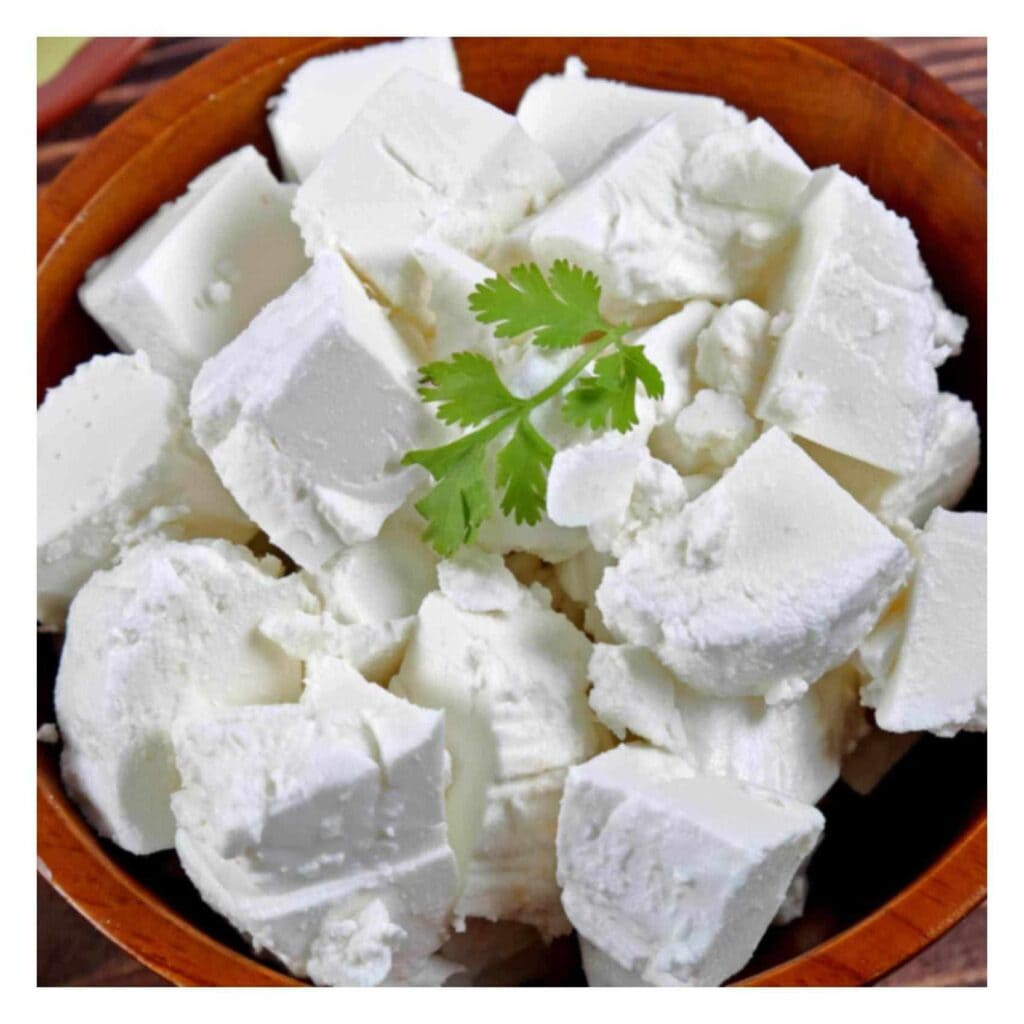
Traditional Egyptian bread
In Egypt, bread is called “Eish,” meaning living. The word denotes the importance of bread as it was used as a sort of currency for those builders and workers on the pyramids.
Aish Baladi/Eish Baladi
Aish Baladi is the Egyptian version of pita bread. It’s made with 100% whole wheat flour baked at extremely hot temperatures and eaten at every meal. An important part of Egyptian cuisine the name Baladi means traditional so Aish Baladi is traditional life.
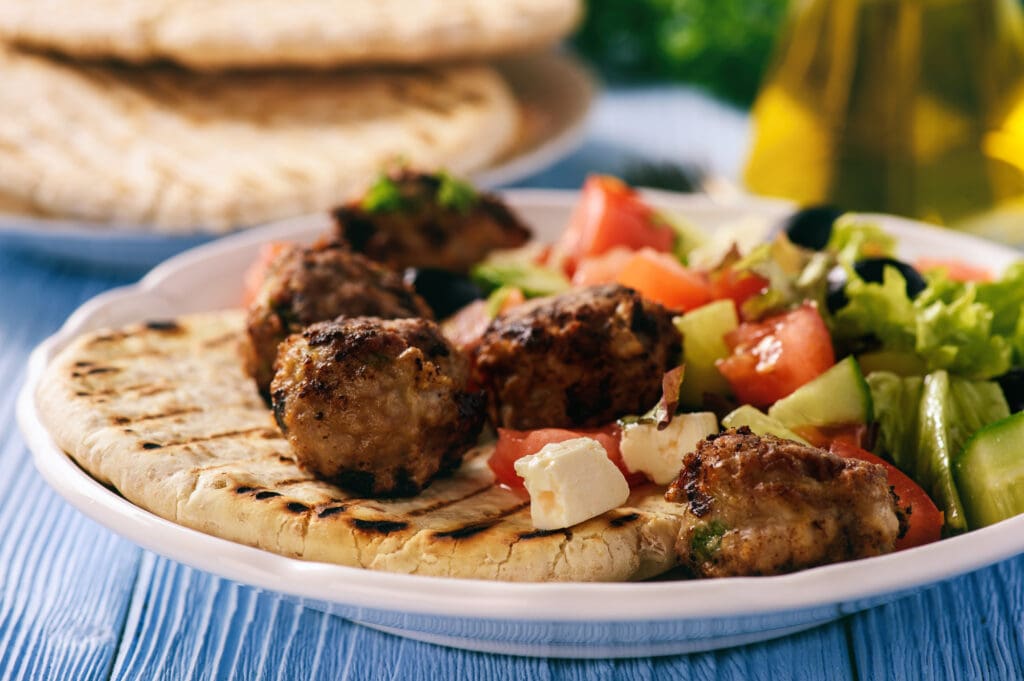
Eish Fino
This is a baguette-shaped bread roll but softer and used with various fillings in sandwich style.
Shamsi
This is traditional Egyptian sourdough bread with slits around the top to guarantee a uniform shape. The bread is baked in domed ovens made from Nile clay with several small openings at the top to let the heat and smoke escape. The baking of this sourdough bread dates back to the times of the ancient Egyptians, and Herodotus mentions this style of bread from Luxor as being very different from the common style of bread in Cairo.
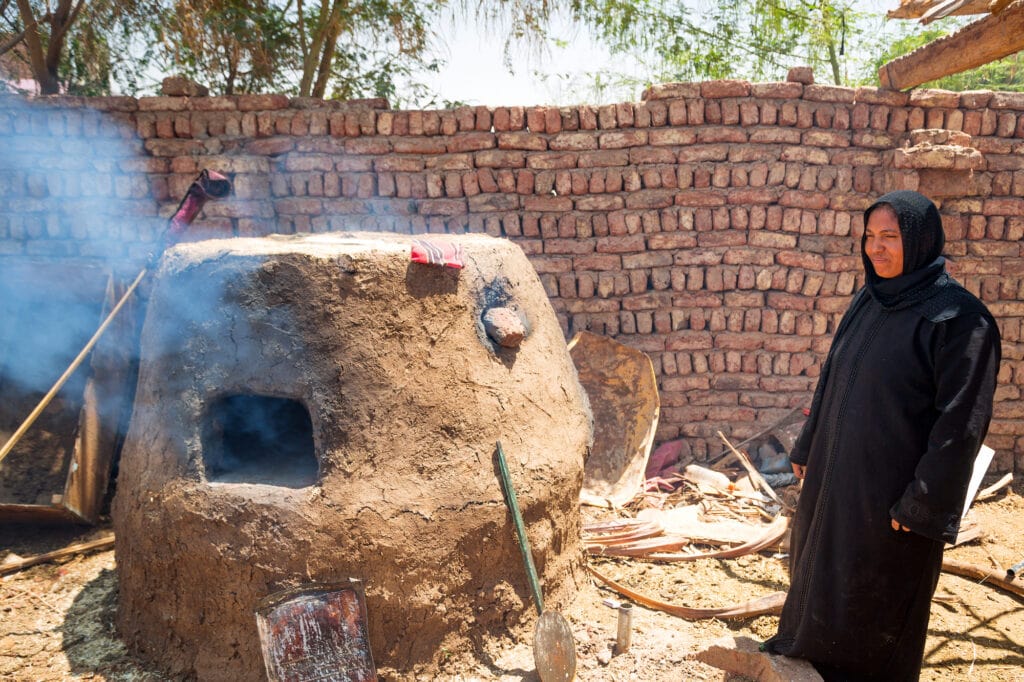
Traditional Egyptian Desserts
Egyptian desserts are quite light and usually delicately flavoured although there are also super sweet types dripping with honey and sugar syrups. You can’t talk about traditional Egyptian foods without discussing desserts.
Umm Ali
This is essentially an Egyptian bread pudding and the name means Ali’s mother this dessert is a simple bread pudding with, sugar, milk, nuts, and raisins. It is also made with layers of puff pastry that are soaked in milk with raisins, nuts, coconut flakes and sugar and then baked.

Baklava
There are numerous different kinds of Baklava but typically it involves layers of filo dough and chopped nuts including pistachios, walnuts, hazelnuts, butter, and spices. The dessert is cut into rectangles or diamonds before being baked and drizzled with a simple sugar syrup infused with honey, rose water, or orange blossom water.
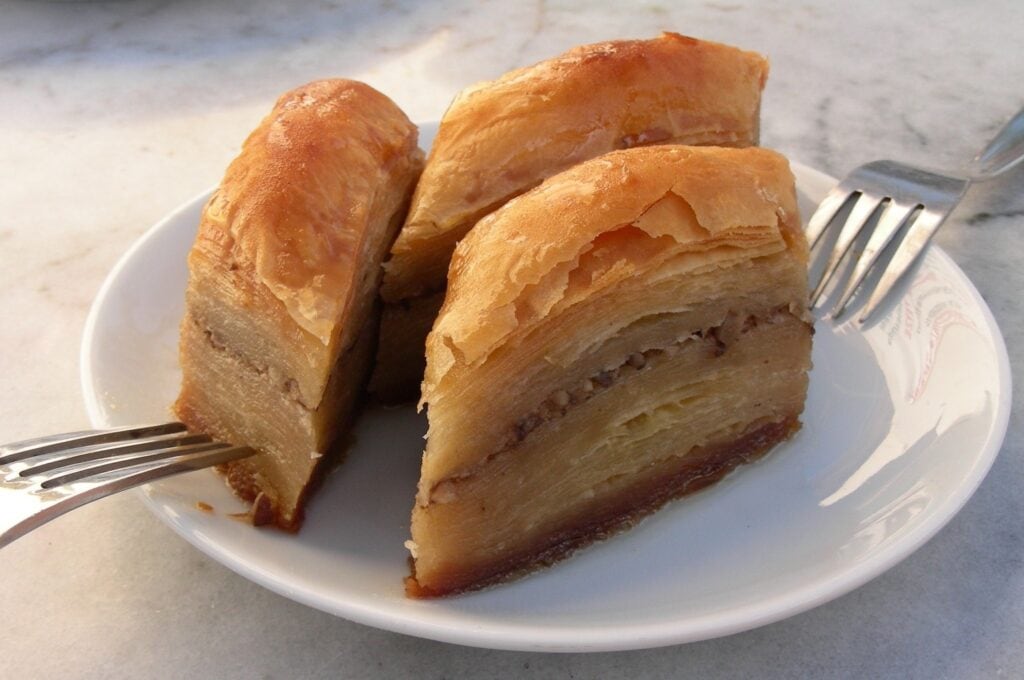
Ghorayeba/ghraybeh/ghoraybeh
A very simple shortbread type of cookie made with powdered sugar, ghee and flour then flavoured with orange blossom or rosewater. This is a celebration cookie for Eid, Easter and Christmas.
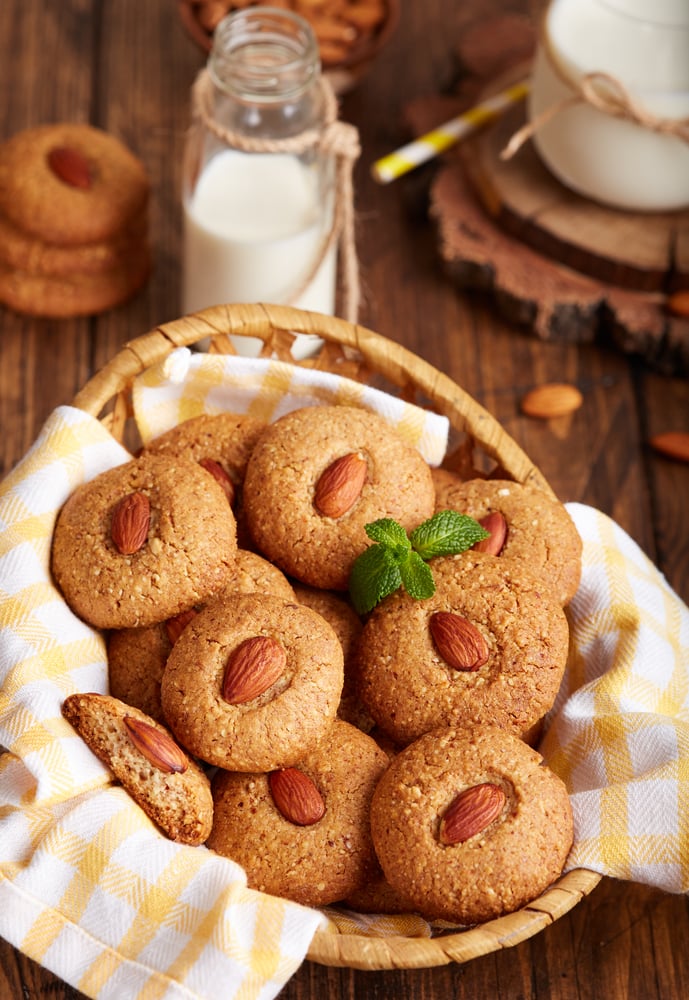
Kanafeh/Konafa/Kunafa
Kanefeh is spelt many ways and it is a luscious Middle Eastern dessert. This is a pastry made with shredded phyllo dough so it looks like vermicelli noodles. The noodles are rolled and flattened and coates with sweet cream cheese and butter. When it is cooked it is soaked again with rose water or orange blossom sugar syrup and served with pistachios and cream.

Qatayef/Katayef
Qatayef is a small Arabic pancake that is folded around nuts and sweet unsalted cheese. This popular dessert is found everywhere during Ramadan.
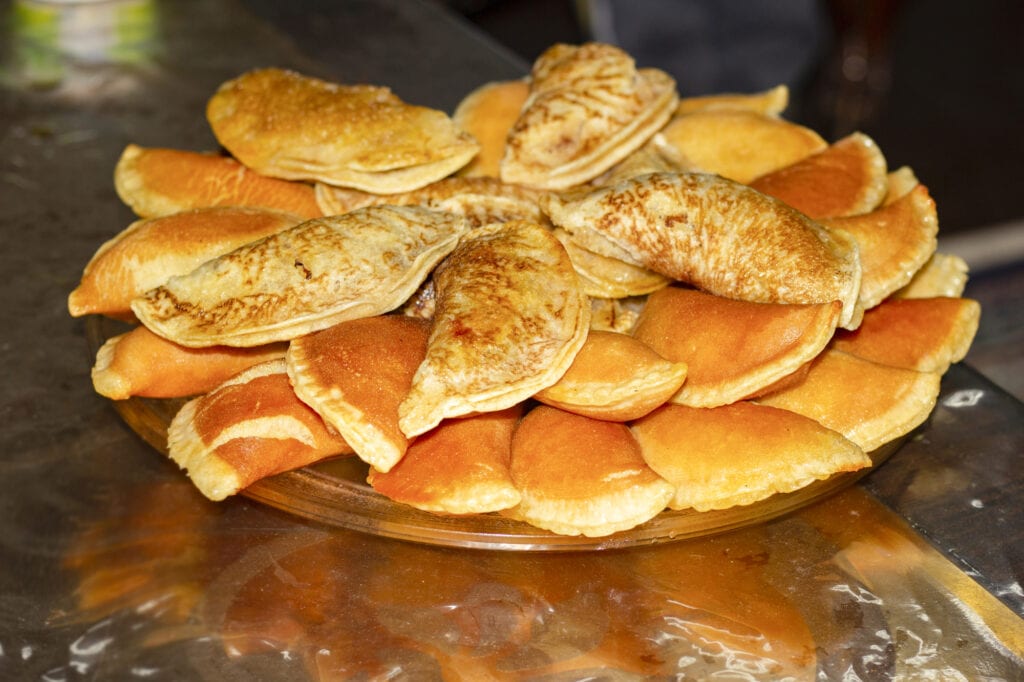
Roz Bel Laban
Very similar to a rice pudding this is made with milk, butter, sugar, vanilla, cinnamon and nutmeg and then infused with Rose or Orange water and garnished with chopped nuts.
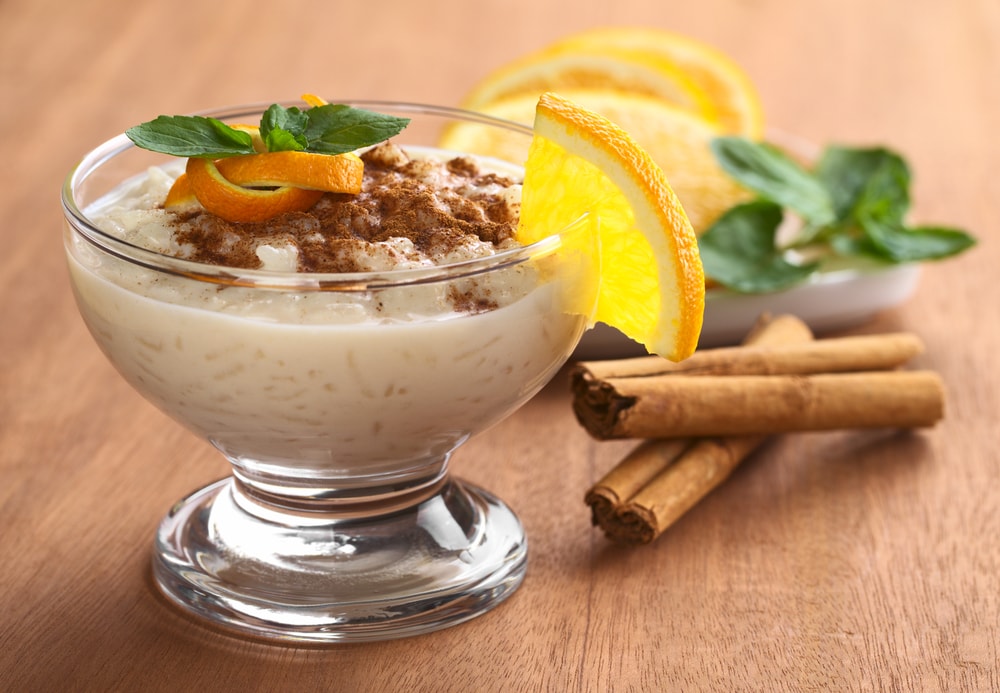
Basbousa
A simple cake made with semolina, coconut, and yoghurt and sweetened with a rose or orange water syrup and decorated with various chopped nuts.
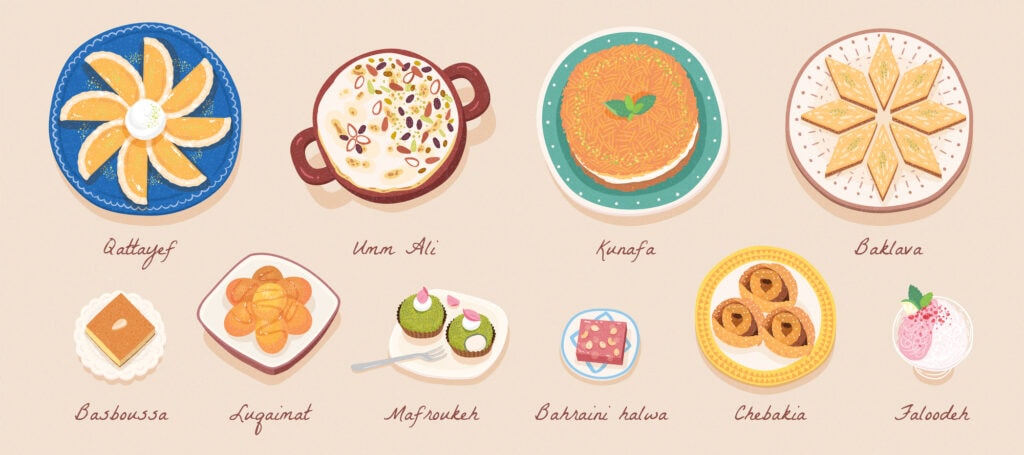
Ka’ak al-Eid
These are small circular cookies that are dusted with powdered sugar and filled with mixtures of honey, nuts, dates and pistachios. They date back centuries in Egypt and are eaten to celebrate Eid at the end of Ramadan.
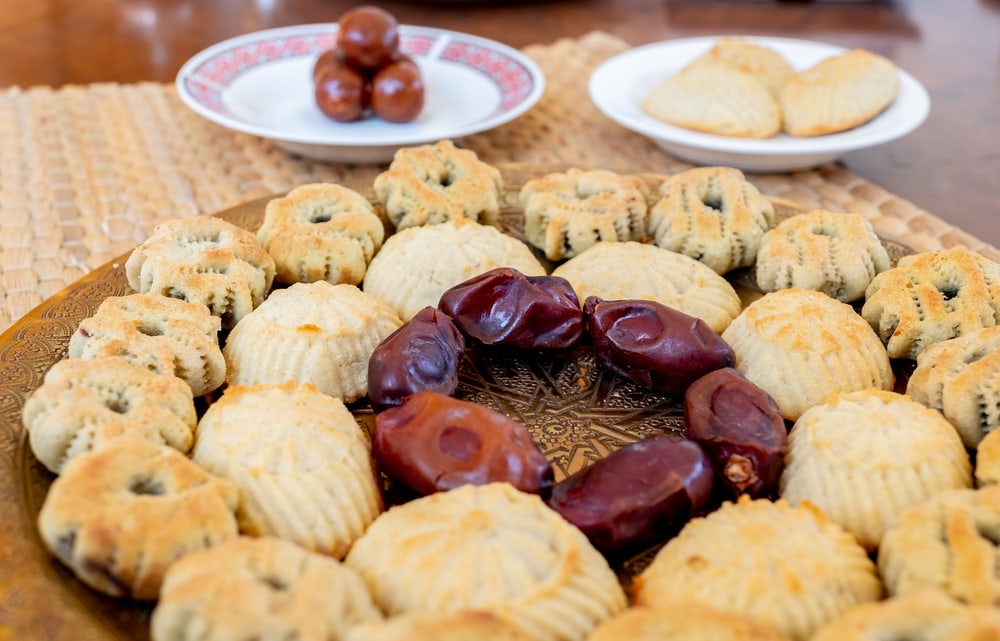
Egyptian Drinks
You can’t talk about Egyptian foods without knowing that most Egyptian meals are served with tea. Herbal teas vary in Egypt from mint teas to hibiscus and black tea.
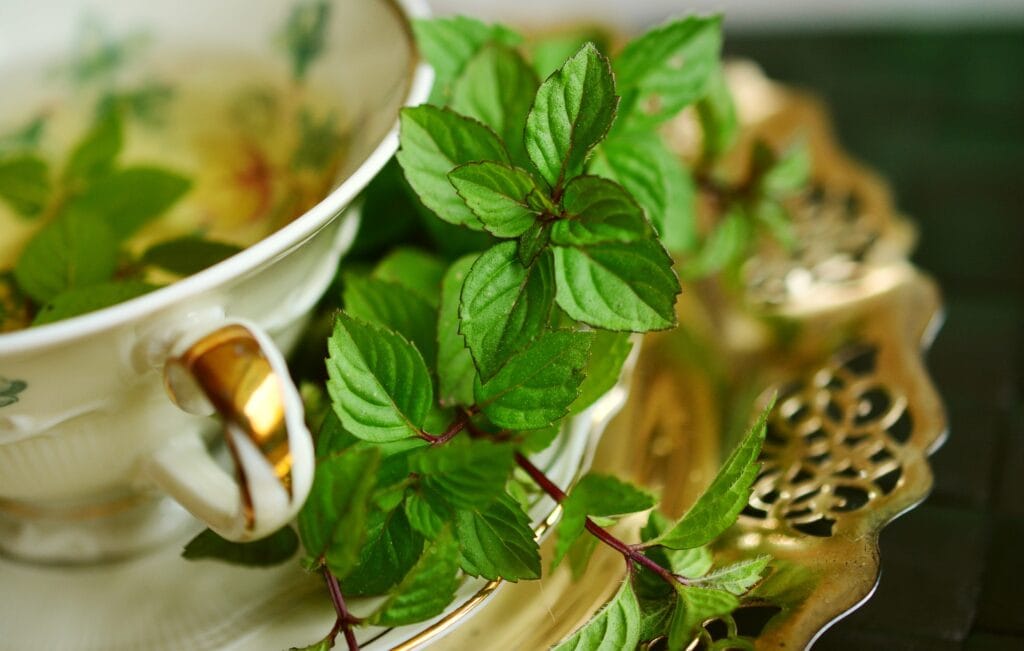
I think my favourite traditional Egyptian food was koshari. We ate koshari all over Egypt and it will always remind me of my trip to this incredible country.
Egyptian cuisine is a true culinary treasure that deserves to be savoured and cherished. From the flavorful koshari to the crispy falafel, every dish tells a story of history, culture, and passion. So next time you’re feeling adventurous, ditch the fast food and give Egyptian food a try. Who knows? You might just discover your new favourite dish – or at least get some great Instagram pics out of it. As they say in Egypt: “Bel hana wel shefa!” (Bon appétit!)
Pin it to save it
